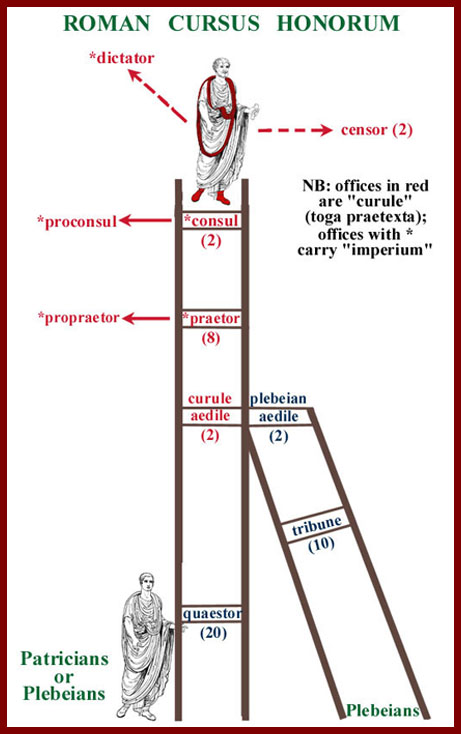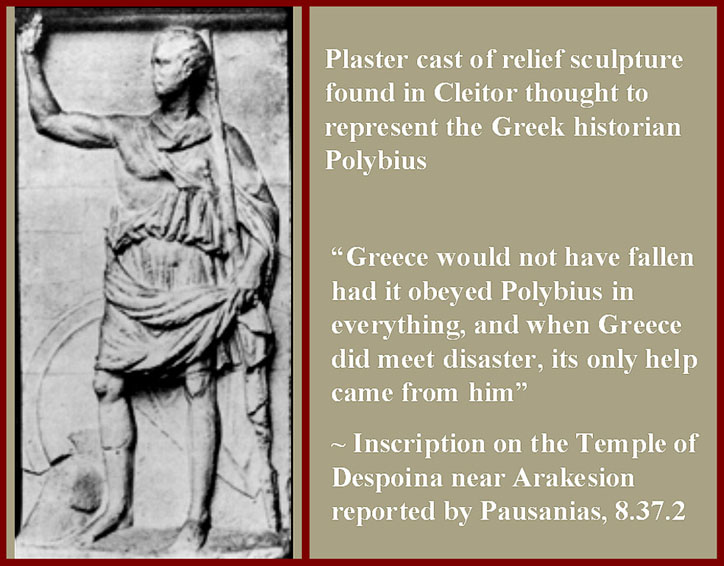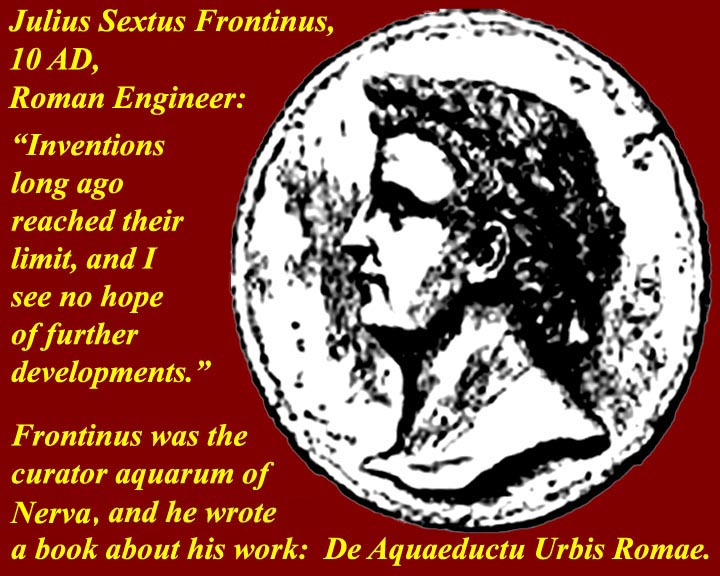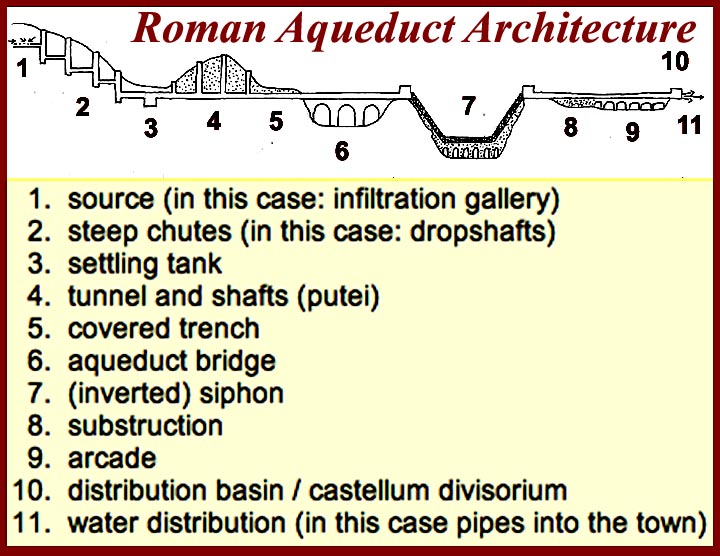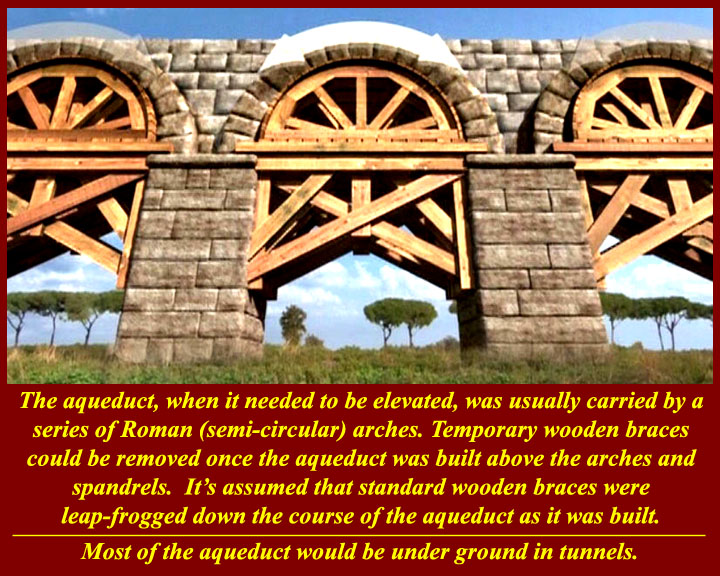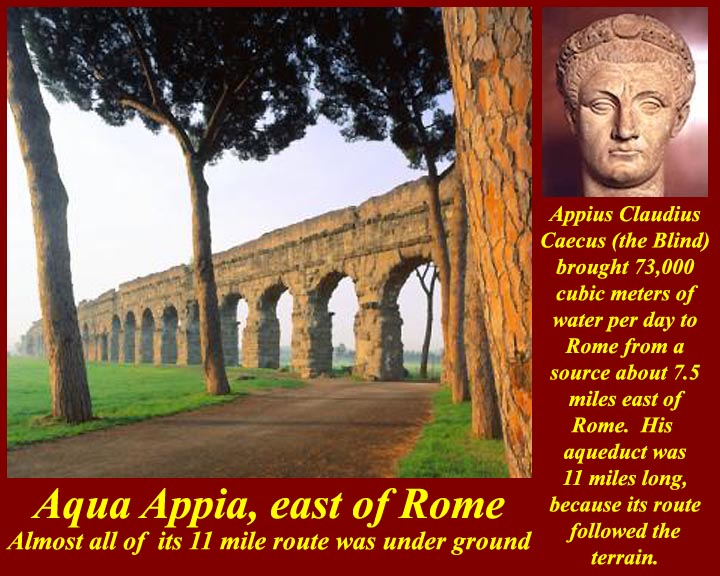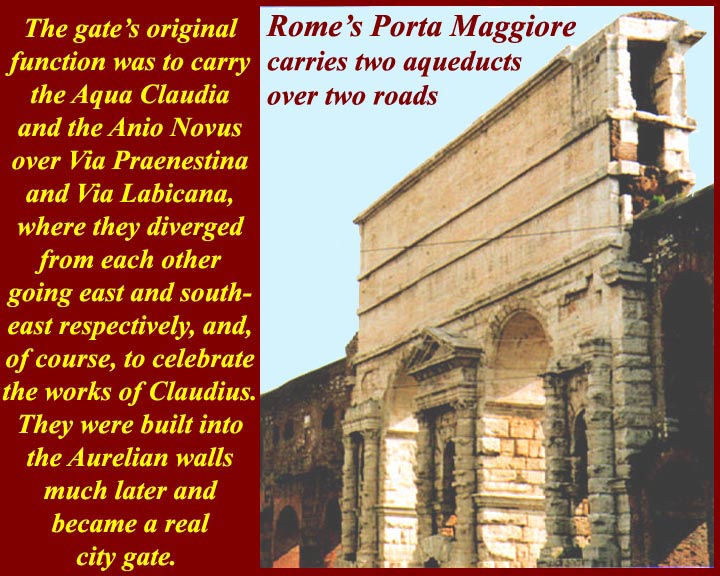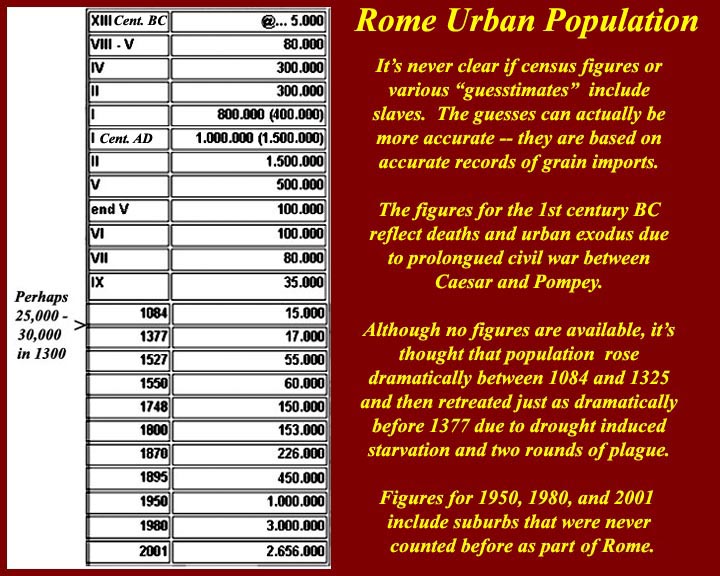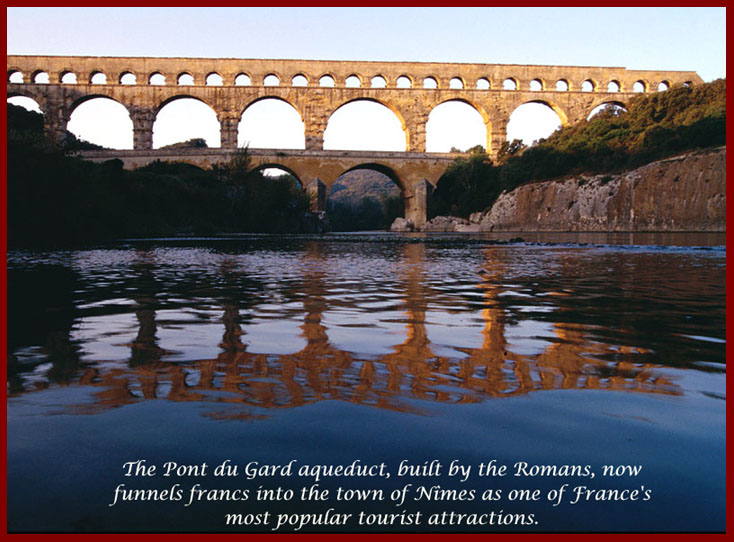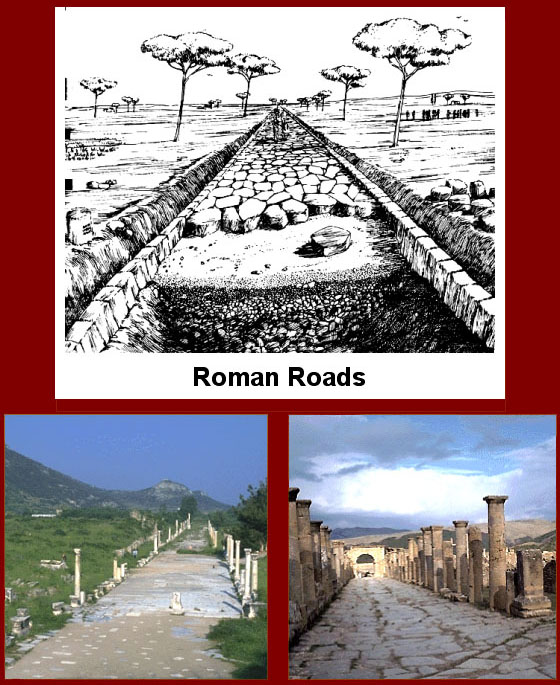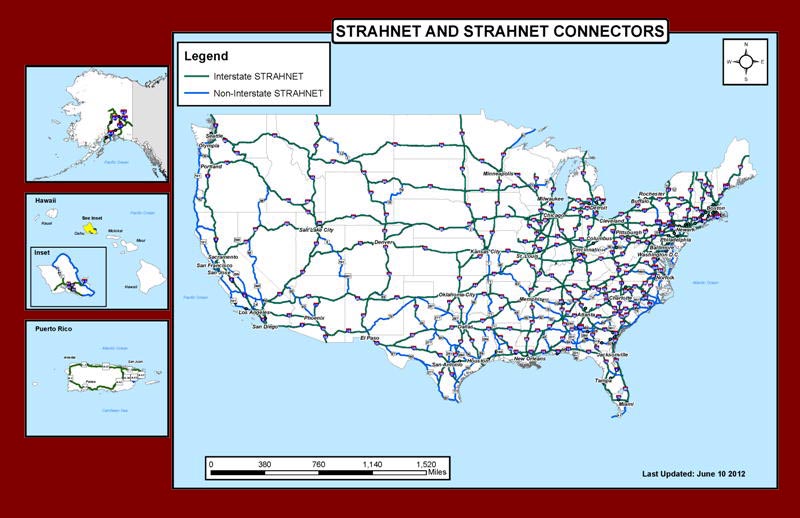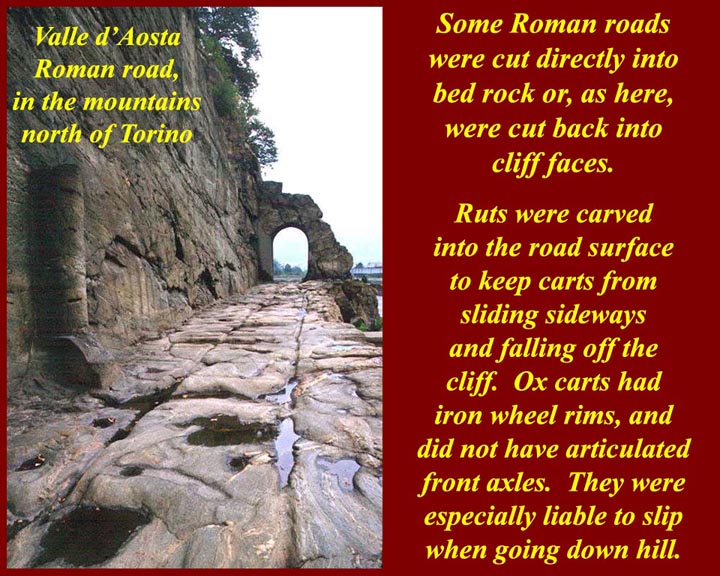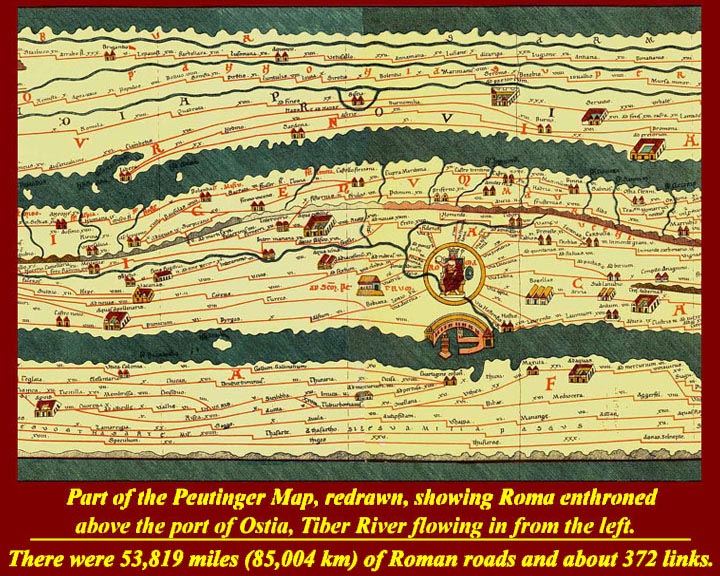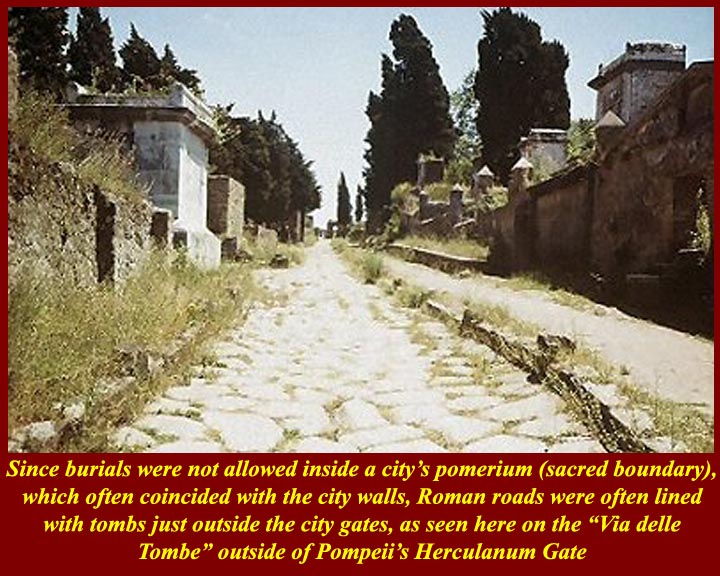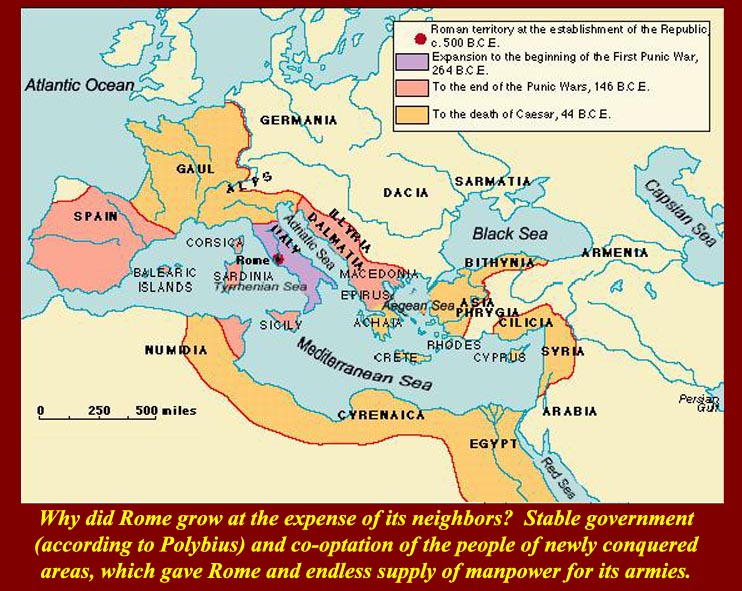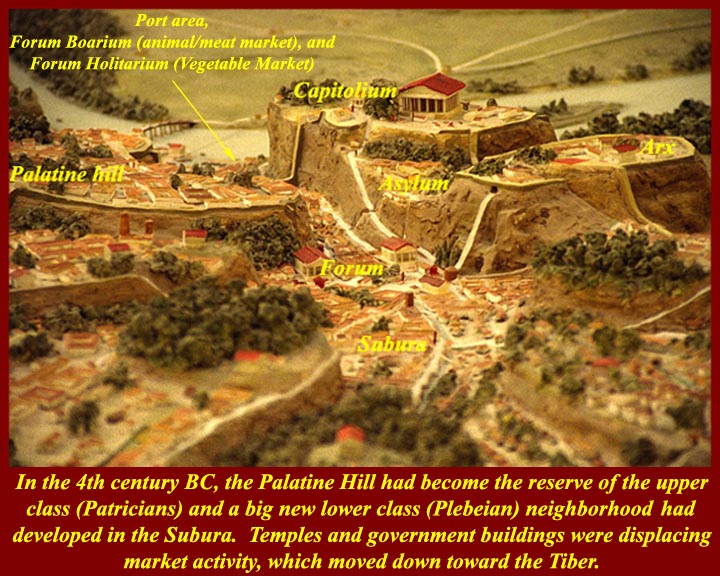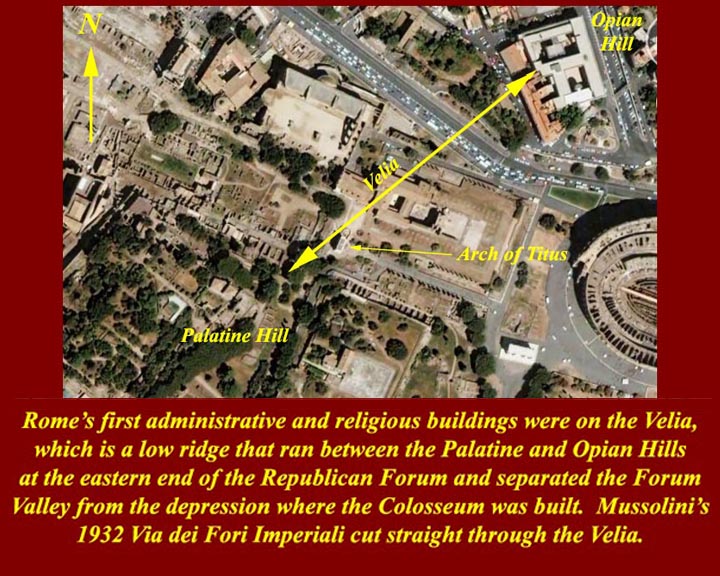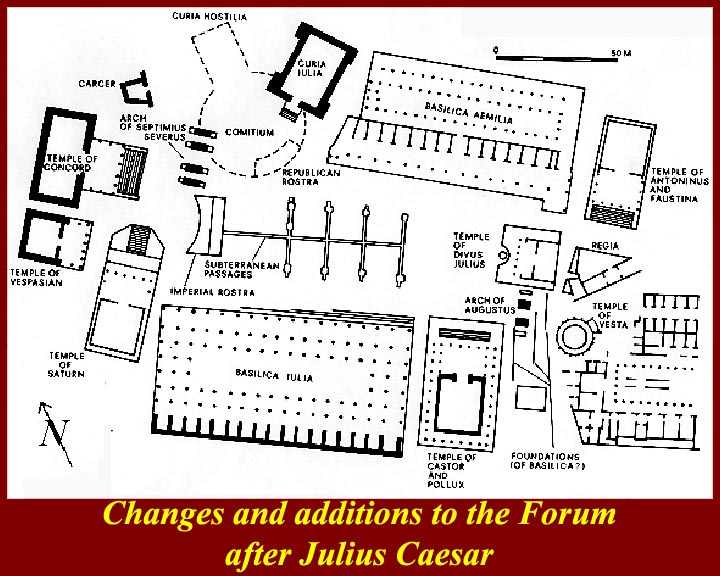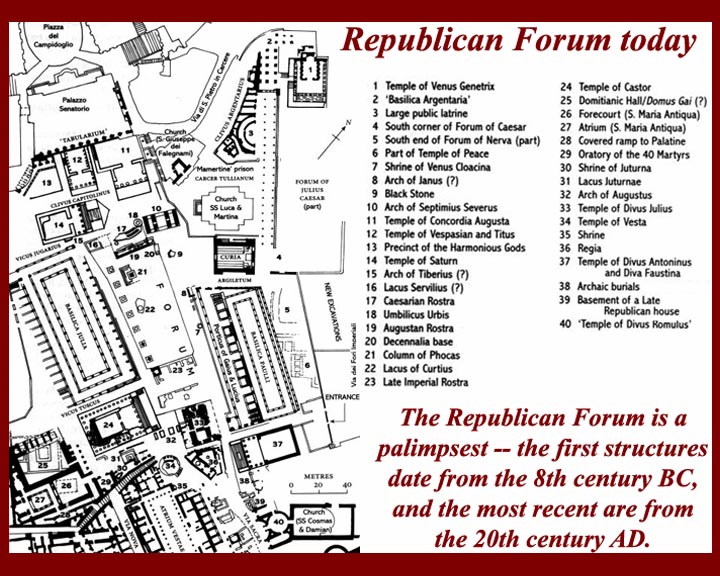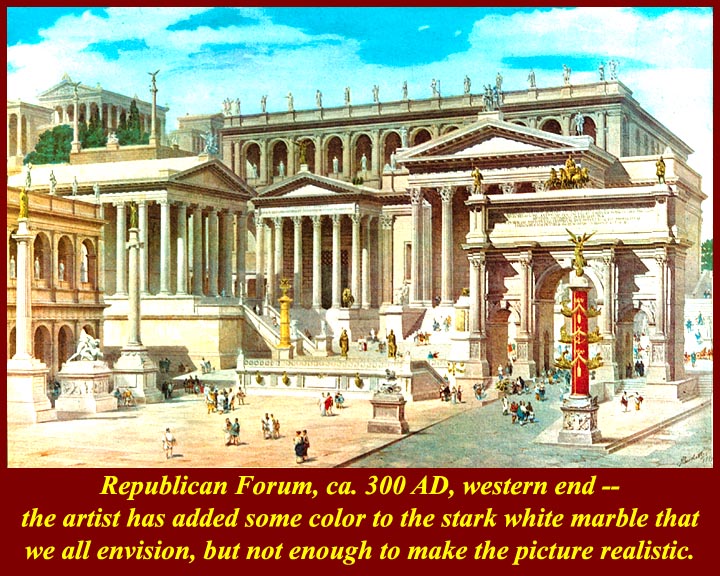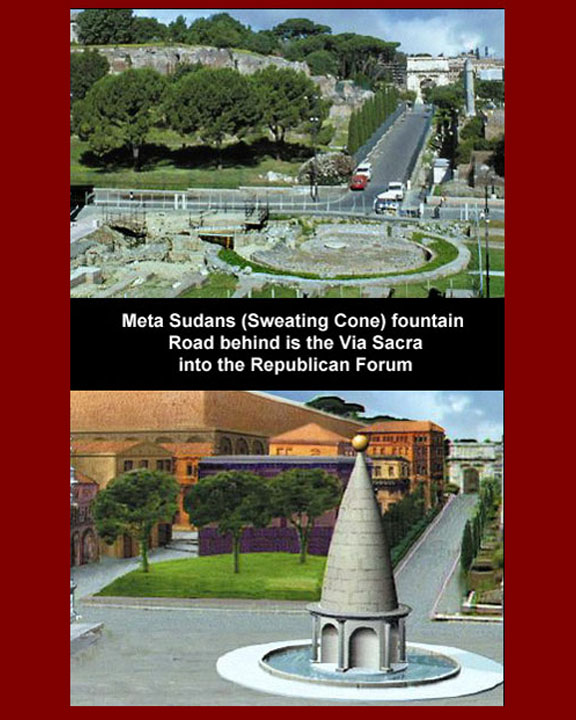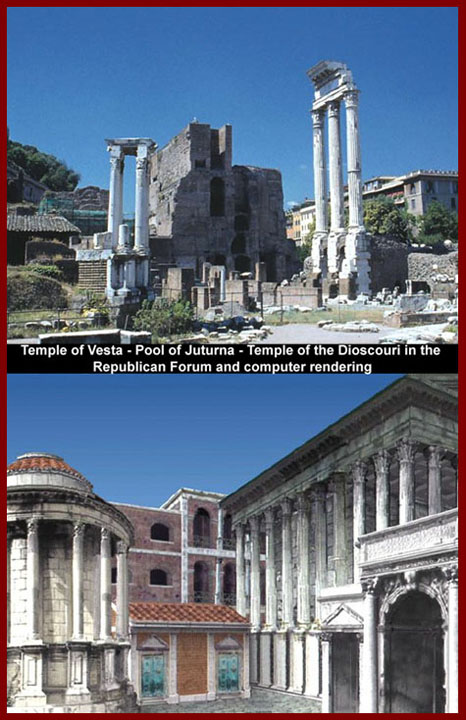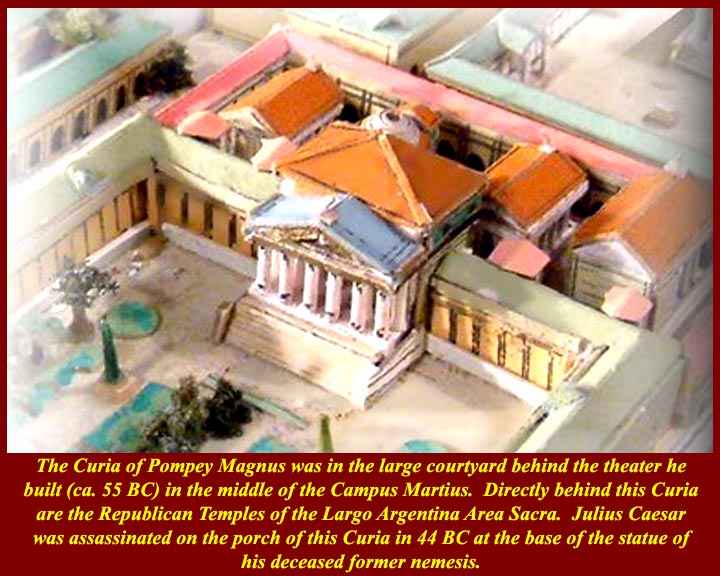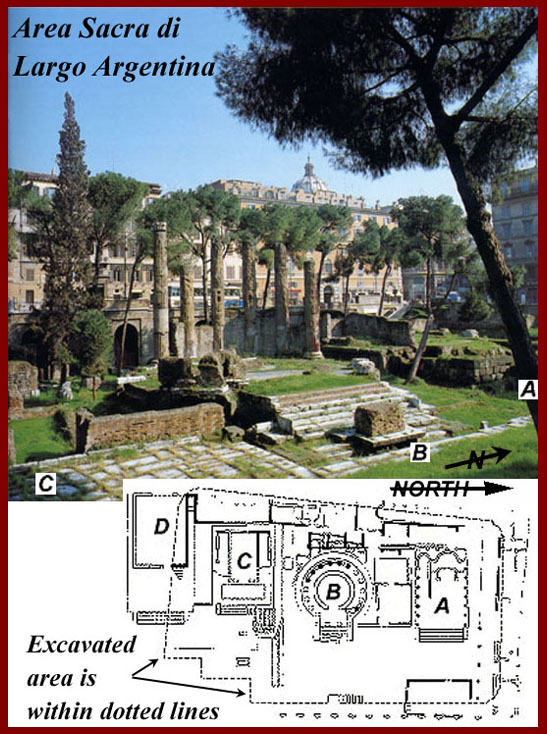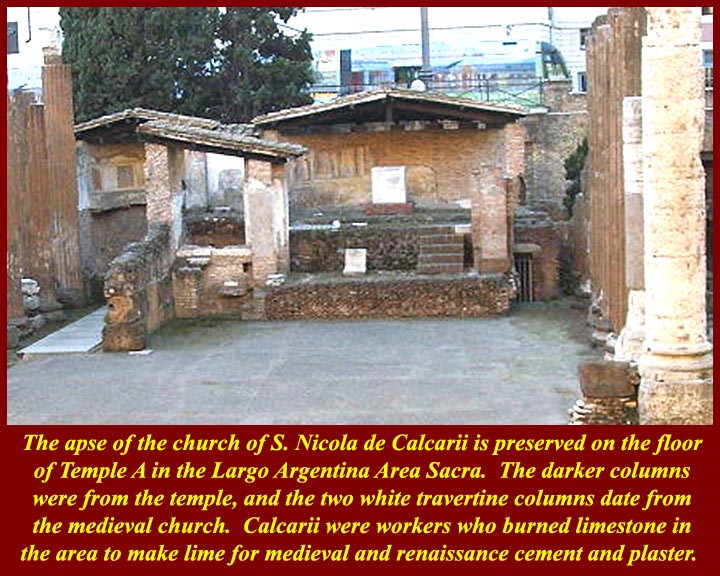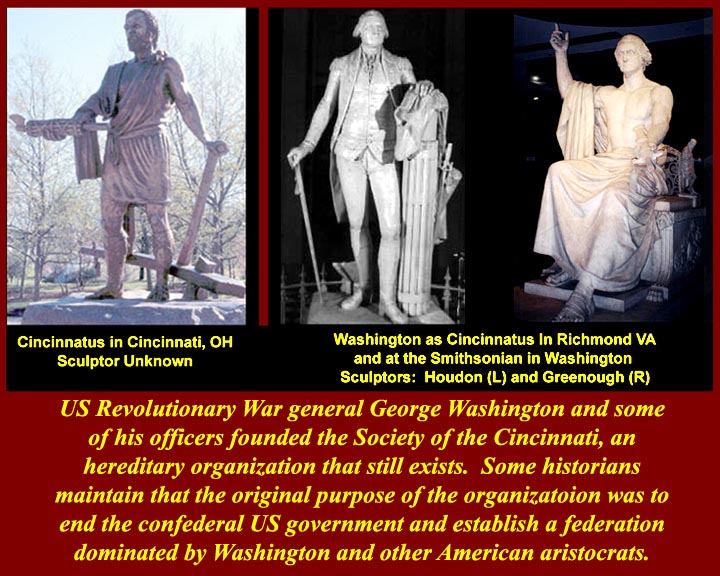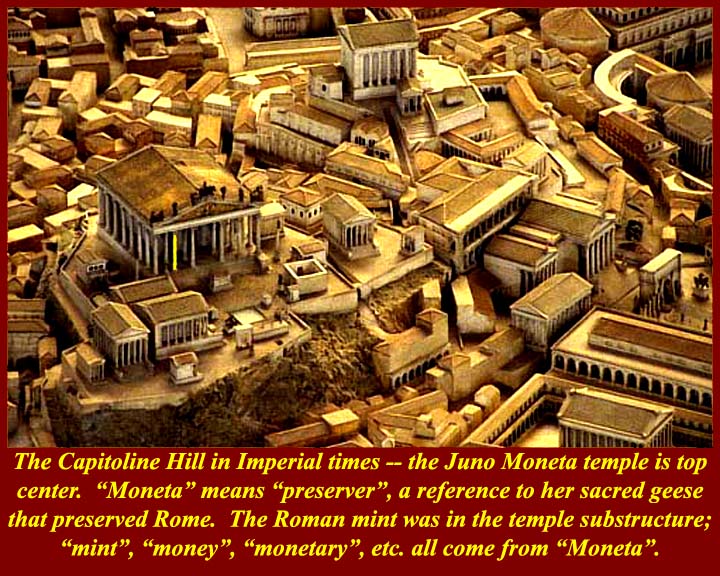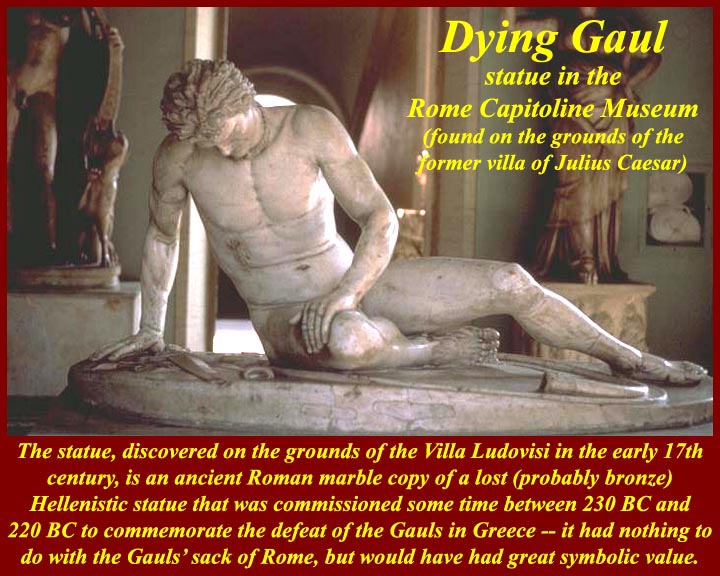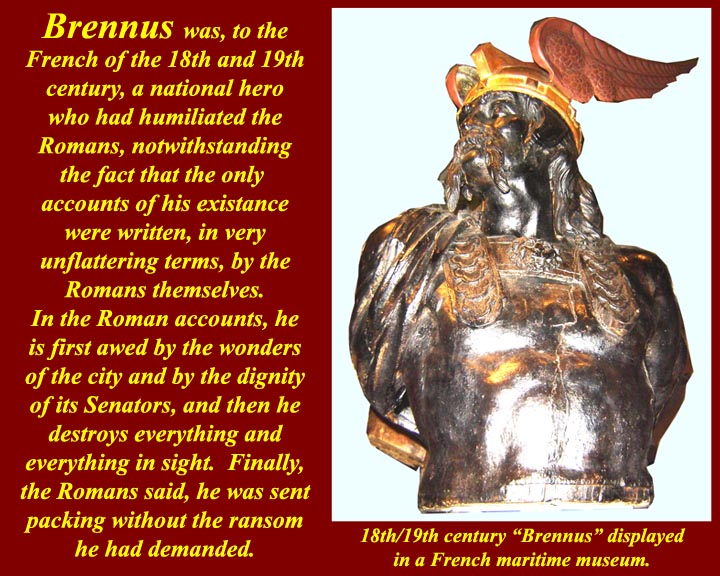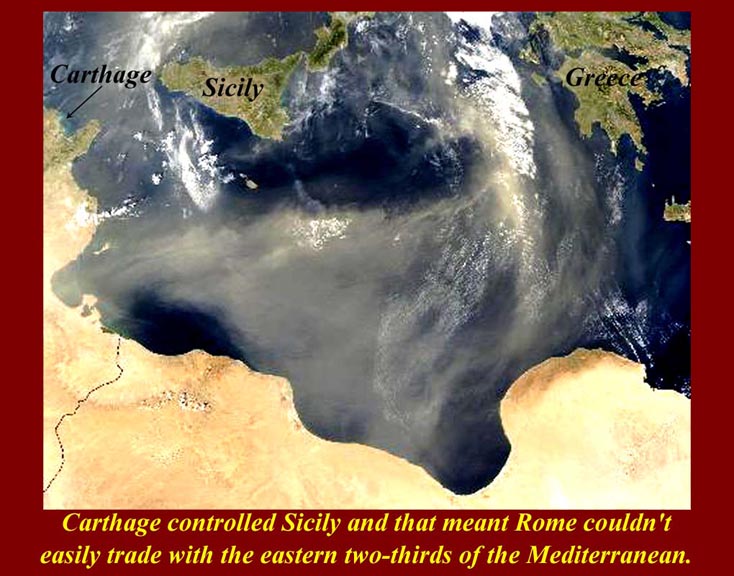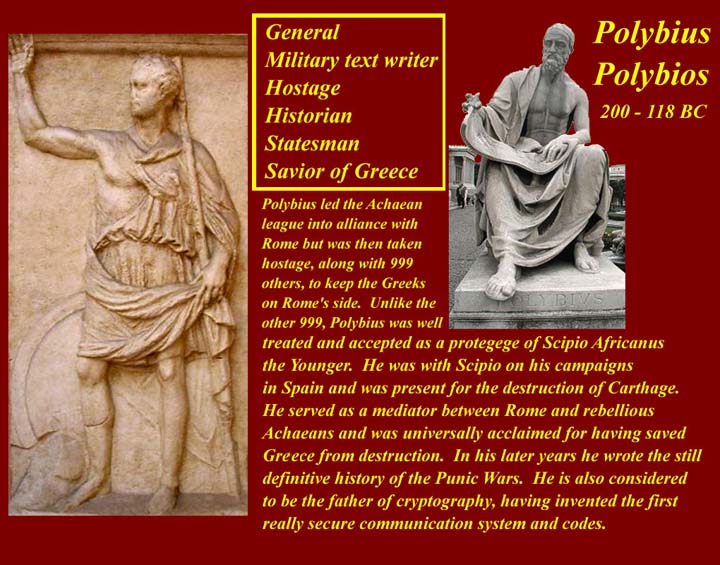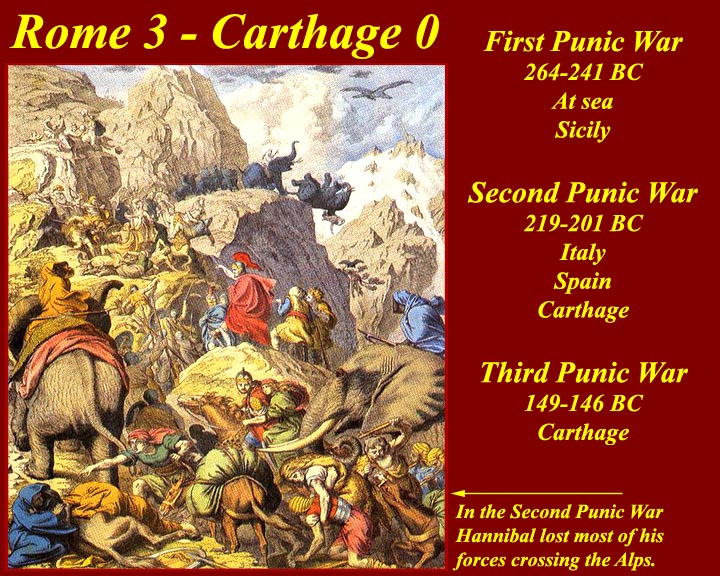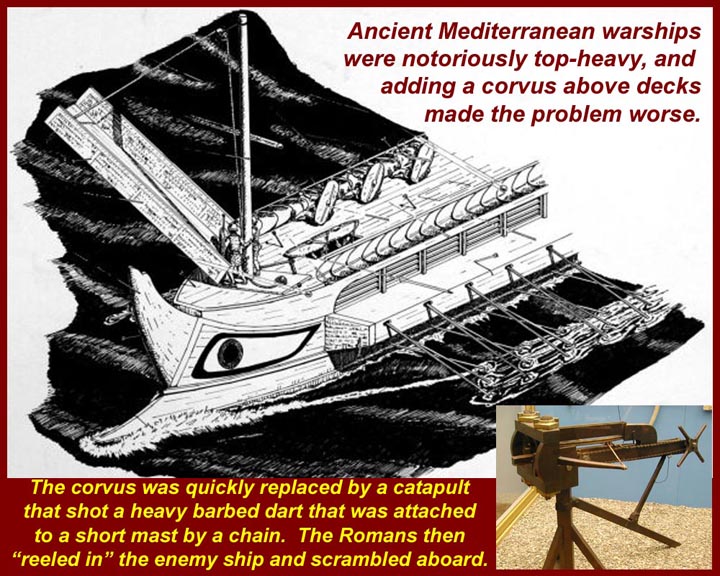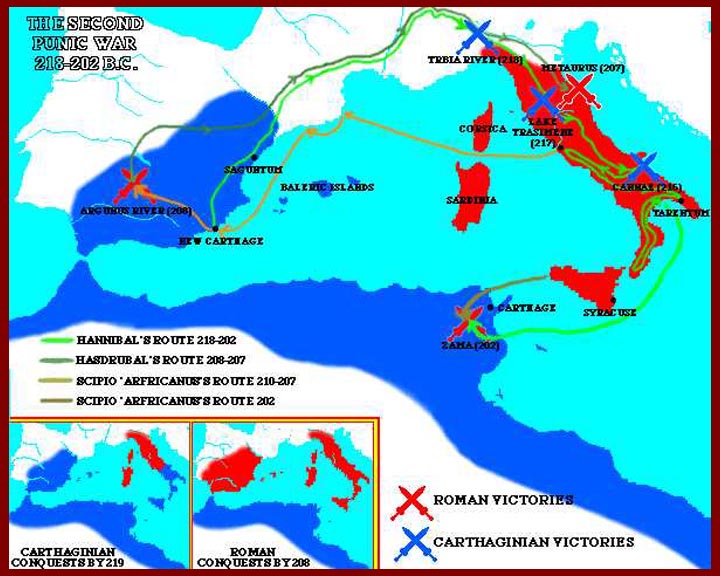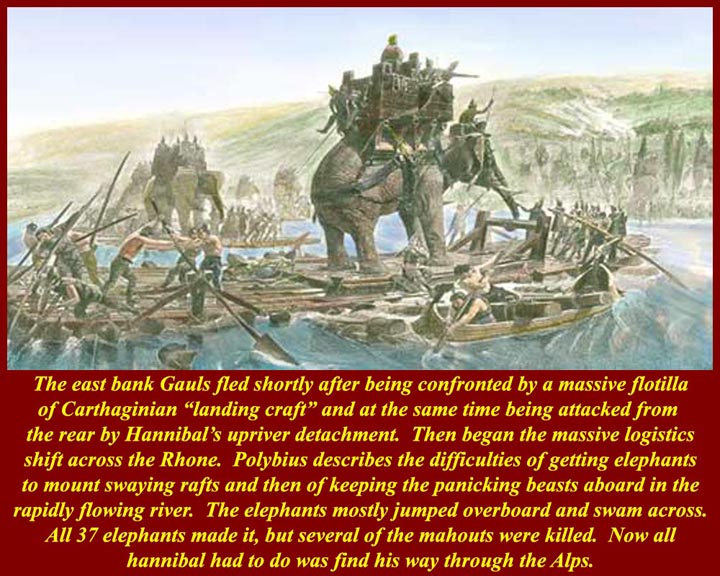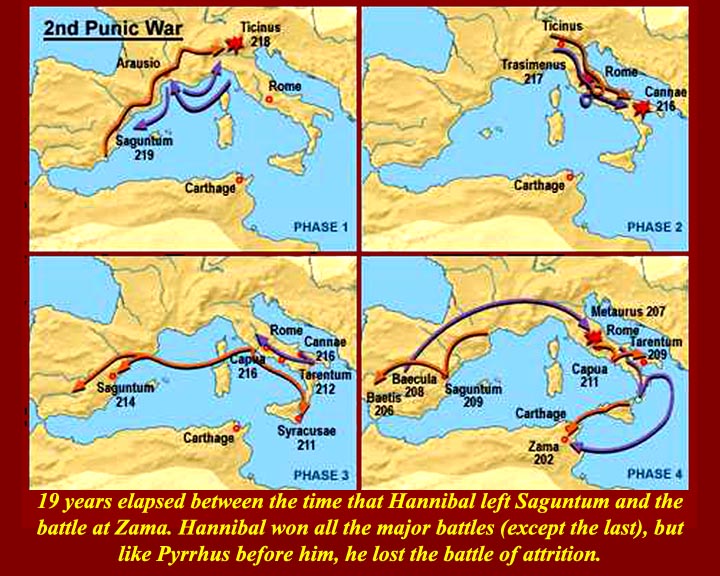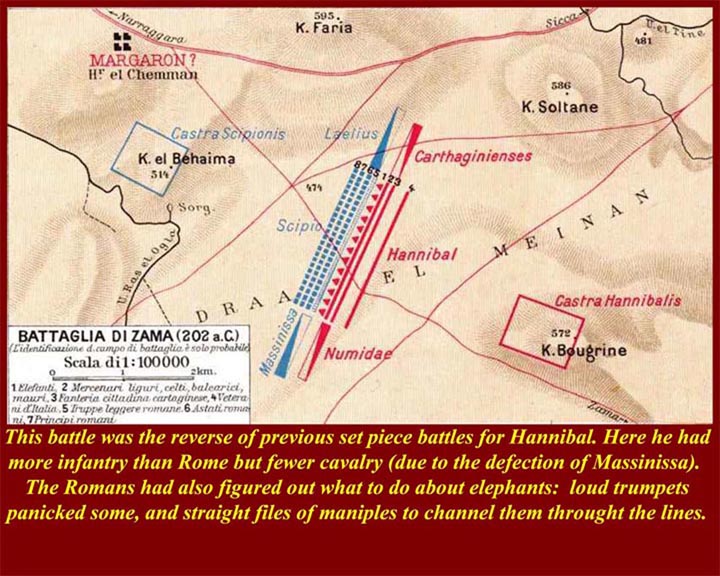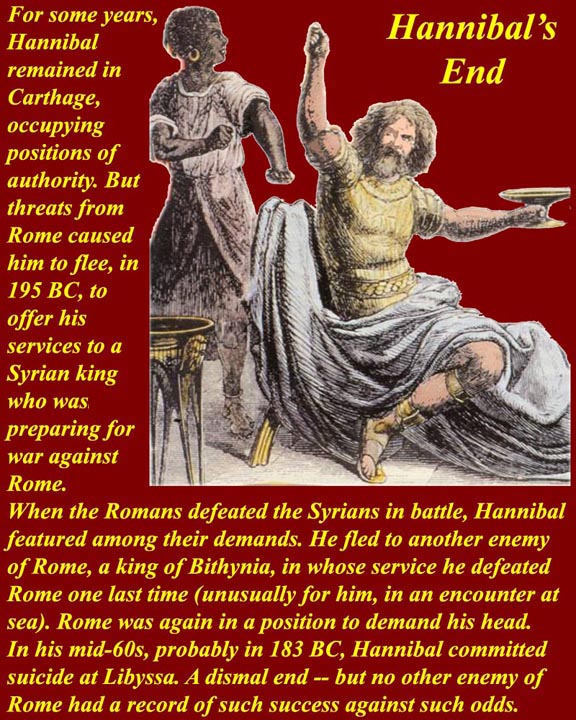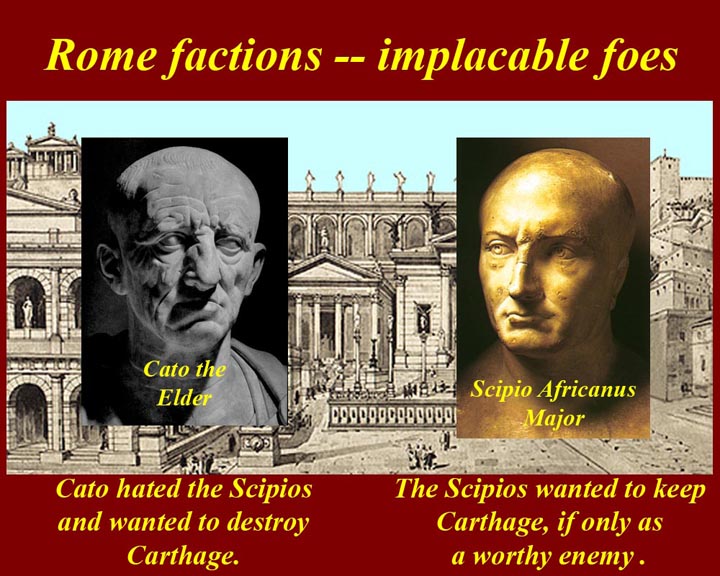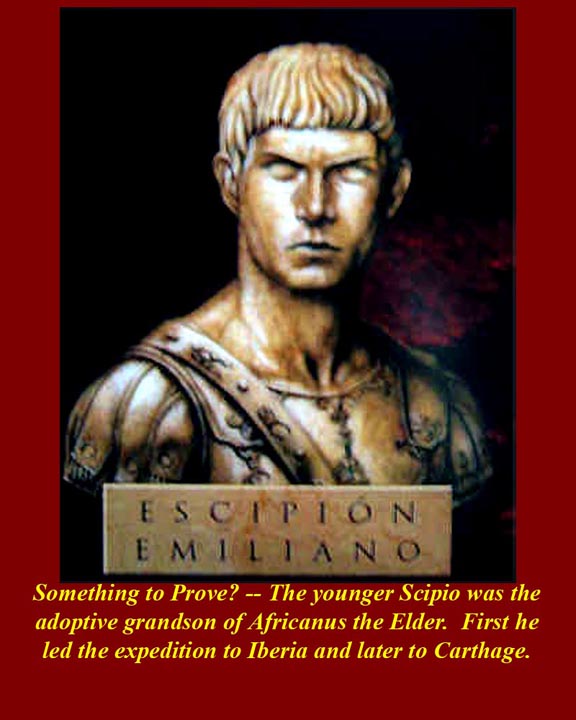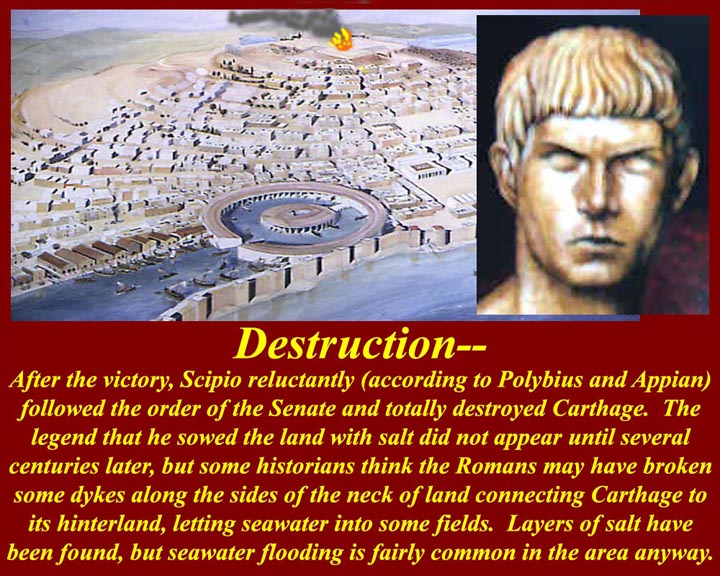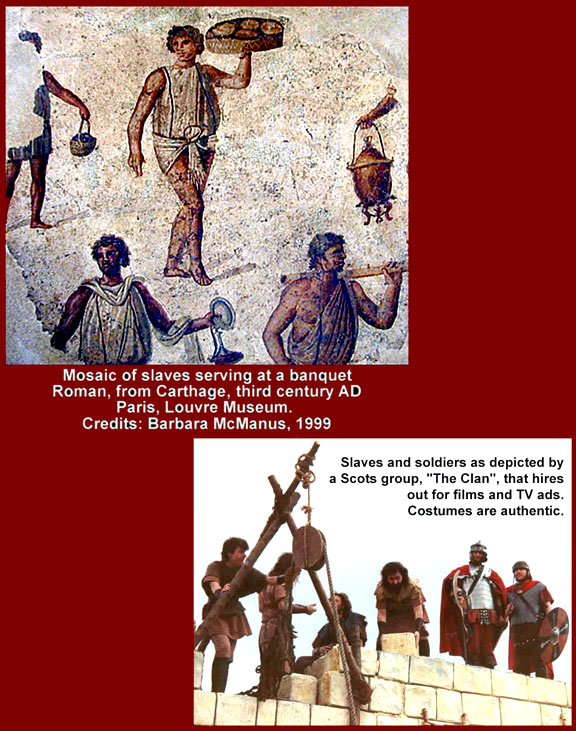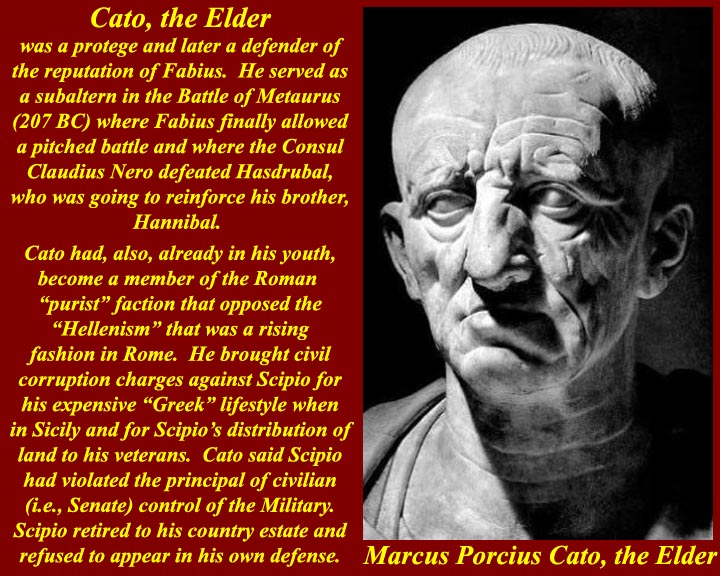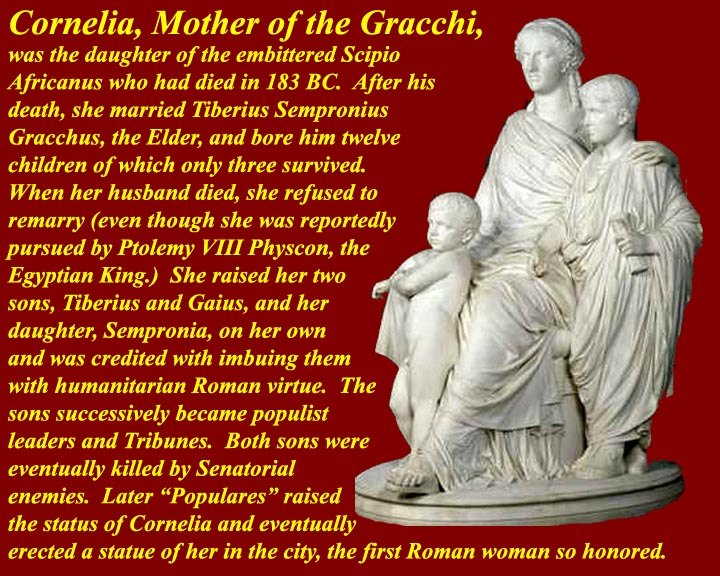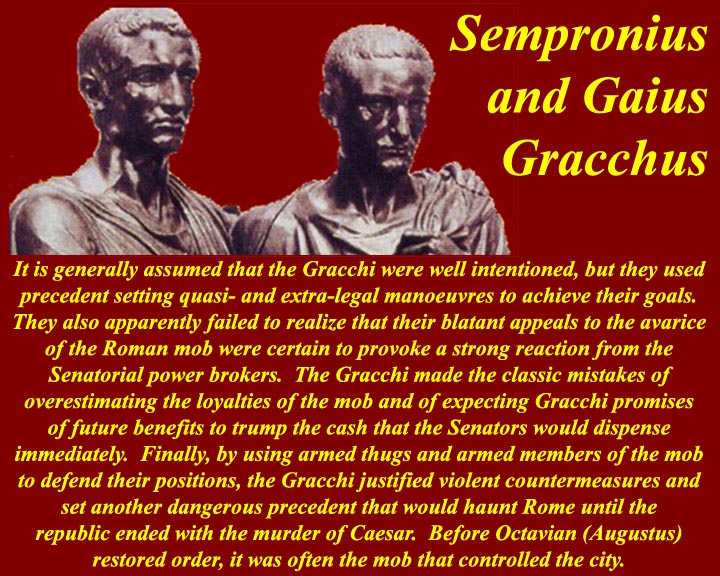Images for ALRI Ancient Rome Unit 3
Republican Rome and the
Republican ForumClick on small images or image links to see larger versions of images
Use your browser "back" key to return to this page from any image.
http://www.mmdtkw.org/AU0301CursusHonorum.jpg
The Cursus Honorum originally was only open to Patricians, but later was open to all Senators. Since membership in the Senate eventually came open to anyone who could meet a monetary requirement, the Cursus Honorum was open to everyone in the "upper classes -- even foreigners once they were accepted into the Senate. In the early Republic, however, the Cursus was as shown in the diagram.
http://www.mmdtkw.org/AU0302Polybius.jpg
The Greek historian Polybius wrote for the Greeks about the Romans. He tried to convince the Greeks that the Roman Republican system, with three branches of government -- executive, legislative, and judicial -- was inherently more stable than any government that relied on only one branch. The Roman Republican system also featured one-year terms for its magistrates and "collegiality in all magistracies, more than one man (yes, always men) at each level. At the Consular level, the two consuls would exchange primacy monthly (at least in theory), and this also applied to consular military responsibilities -- they switched overall command monthly. Polybius didn't live long enough to see the system fall apart.
http://www.mmdtkw.org/AU0303aFrontinus.jpg
Among the most important vectors of the rise of Rome was the provision of enough water to support an overwhelmingly large city. Rome's power was man-power, and to concentrate enough men to make an overwhelming force, you had to provide huge amounts of water. What we know about Rome's water supply and how water was distributed first in Rome and later in its satellites, might have been deduced from physical remains, but that wasn't necessary, because one of the men in charge of the city's water and sewer department -- the one in charge during the reign of Nerva, when the water system was almost fully developed -- kept meticulous records and wrote a book on the functioning and history of Rome's water. De aquaeductu urbis Romae (On the Aqueducts of the city of Rome), written by Sextus Julius Frontinus towards the end of the first century AD, is the first known published official report of an investigation about engineering works.
http://www.mmdtkw.org/AU0303bAqueductArchitecture.jpg
Water was collected at distant sources and brought to the city by gravity flow. Most of the aqueducts flowed below ground; stretches of aqueducts raised on arches were relatively rare, but those stretches tended to be near the city -- where they can still be seen by tourists. The reason for this was that it always was important to bring the water to the highest points of the city on each of which would be located a castellum divisorium from whence water would flow, again by gravity, to private users and public fountains. Much of Rome's water supply still flows into the city through the ancient aqueducts -- although now they now often have plastic or metal pipes or linings rather than the ancient Roman hydraulic cements and plasters. The building behind the Moses Fountain in Rome's Piazza San Bernardo (see http://en.wikisource.org/wiki/Fountains_of_Papal_Rome/Fontana_del_Mosè) is a castellum divisorium of the Alexandrina aqueduct (built in 226 AD by Emperor Alexander Severus, renamed Aqua Felice after Pope Sixtus V), and the large building behind the Trevi Fountain (http://en.wikipedia.org/wiki/Trevi_Fountain) is a castellum divisorium for the Aqua Virgo (built in 19 BC by Marcus Agrippa, during the reign of the emperor Augustus).
http://www.mmdtkw.org/AU0303cAqueductArch.jpg
Although the Romans did not really invent the semicircular arch, they certainly built many of them. The image shows how uniformity was maintained and how arches were supported during construction.
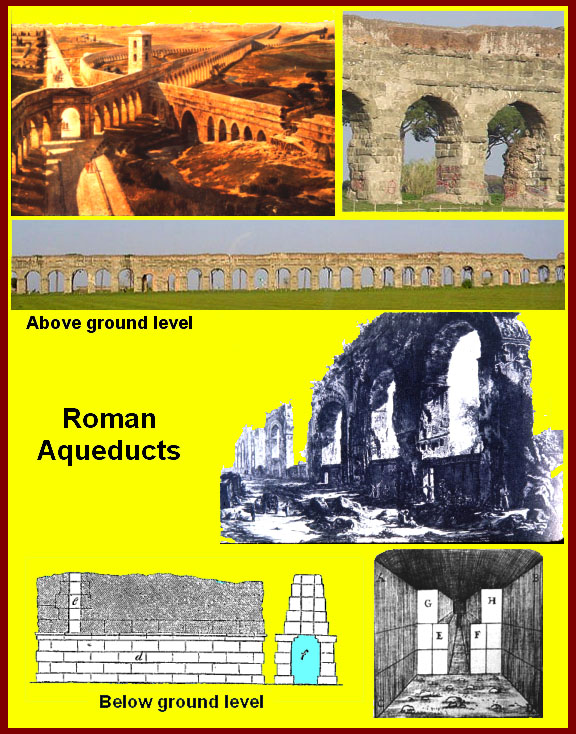
http://www.mmdtkw.org/AU0303dRomanAqueducts.jpg
http://www.mmdtkw.org/AU0303eAqueduct.JPG
"Ancient Rome had eleven major aqueducts, built between 312 B.C. (Aqua Appia) and 226 A.D. (Aqua Alexandrina); the longest (Anio Novus) was 59 miles long. It has been calculated that in imperial times, when the city's population was well over a million, the distribution system was able to provide over one cubic meter of water per day for each inhabitant: more than we are accustomed to use nowadays.
"For most of their length the early aqueducts were simply channels bored through the rock, from the water intake in the hills almost to the distribution cistern in Rome. The depth of the channel below ground varied so as to maintain a constant, very shallow gradient (less than 1/200) throughout the length of the aqueduct; vertical shafts were bored at intervals to provide ventilation and access. Only in the final stretches was the conduit raised on arches, to give a sufficient head for distribution of the water within the city." (from the first linked page, below)
For more than you ever wanted to know about Roman Aqueducts, see https://www.essays24.com/essay/Roman-Aqueducts/5004.html and http://en.wikipedia.org/wiki/Aqueduct.
Marcus Vitruvius Pollio wrote on Water and its conveyance in his De Architectura, Book VIII available in English translation at http://penelope.uchicago.edu/Thayer/E/Roman/Texts/Vitruvius/8*.html.
A "New" (2003) translation of Frontinus De Aquaeductu Urbis Romae by R. H. Rodgers of the The University of Vermont is at http://www.uvm.edu/~rrodgers/Frontinus.html.
http://www.mmdtkw.org/AU0303fAquaAppia.jpg
"The Aqua Appia was the first Roman aqueduct. It was constructed in 312 BC by Appius Claudius Caecus, the same Roman censor who also built the important Via Appia. Its source, which Frontinus identifies as being about 780 paces away from via Praenestina, was allegedly established by Caius Plautius Venox.
"The Aqua Appia flowed for 16.4 km into the city of Rome through the Porta Maggiore, and emptied into the Forum Boarium, near the Porta Trigemina. Nearly all of its length was underground, which was necessary because of the relative heights of its source and destination, and afforded it protection from attackers during the Samnite Wars that were underway during its construction. It dropped only 10 m over its entire length, making it a remarkable engineering achievement for its day.
"Frontinus calculates that the aqueduct was capable of delivering 73,000 cubic meters of water a day into Rome." (from http://en.wikipedia.org/wiki/Aqua_Appia which has links to other pages.)
http://www.mmdtkw.org/AU0303gRome.Porta_Maggiore.jpg
Raised aqueducts were extremely expensive to build and to maintain, so it's not unexpected that the same sets of arches might carry more than one stream of water from different sources. In the image we see the Aqua Claudia superimposed on the Aqua Anio Novus, two Aqueducts dedicated by Claudius in 52 AD.
(a)(b)
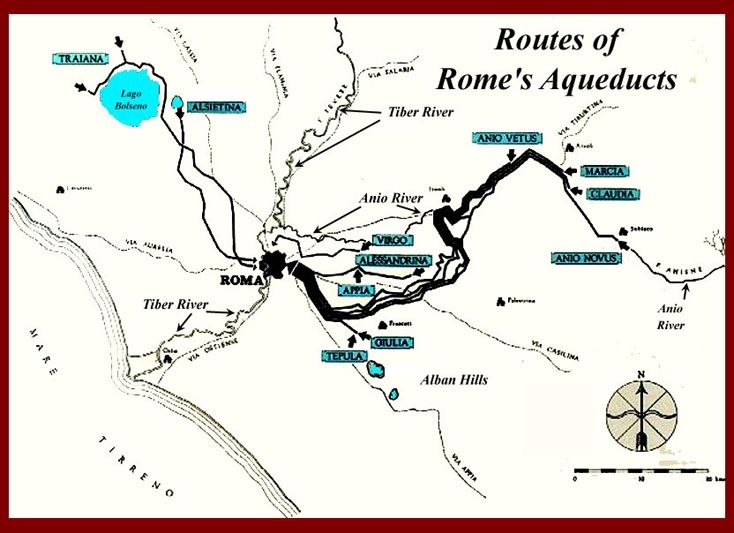
http://www.mmdtkw.org/AU0303hAqueductsRomeEarlyRepublic.jpg
http://www.mmdtkw.org/AU0303iAquaeMap.jpg
The maps show the aqueducts that carried water to Rome during the early Republic (a) and the final count of ancient Roman aqueducts (b).
A good digest of construction of Rome's aqueducts is at http://en.wikipedia.org/wiki/List_of_Roman_aqueducts_by_date.
A chart of Rome's aqueducts including their length and capacity is at http://en.wikipedia.org/wiki/List_of_aqueducts_in_the_city_of_Rome
For more on Roman aqueducts, see https://archserve.id.ucsb.edu/courses/arthistory/152k/water.html, which also has many images of Roman aqueducts and water works.
http://www.mmdtkw.org/AU0303jRomeCityPopulation.jpg
Rome needed all the water it could get to cater to the lifestyle of it population. When the city was fully developed, each Roman used more than one cubic meter of water per day -- the baths were very big users.
http://www.mmdtkw.org/AU0303kPontDuGard.jpg
We can't talk about aqueducts without showing the Pont Du Gard.
http://www.mmdtkw.org/AU0304aRomanRoads.jpg
All roads lead to Rome (actually almost all of them led from Rome; they were designed and built by the Roman armies to move troops from Rome and to crisis areas. For more on Roman roads, see http://penelope.uchicago.edu/Thayer/E/Gazetteer/Periods/Roman/Topics/Engineering/roads/home.html and at http://www.crystalinks.com/romeroads.html.
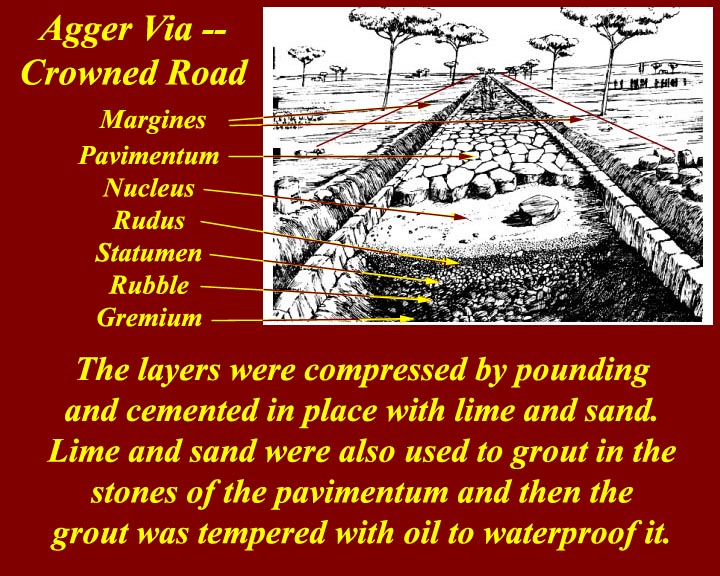
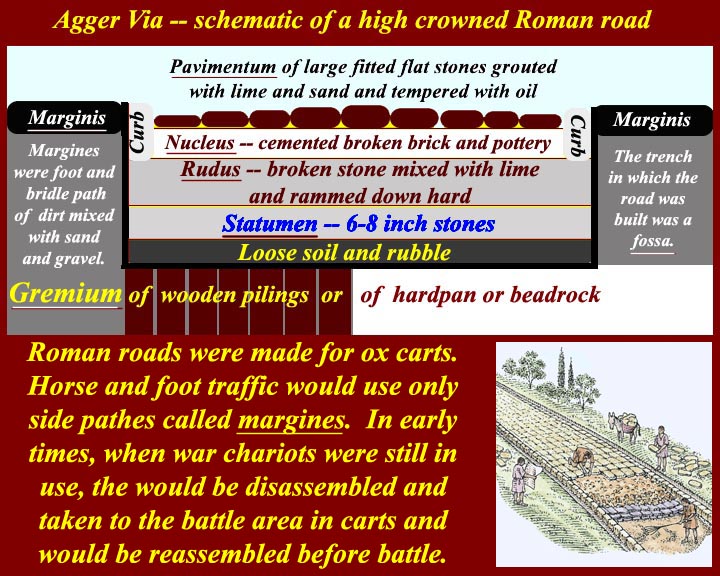
http://www.mmdtkw.org/AU0304bbAggerVia2.jpg
http://www.mmdtkw.org/AU0304cAggerVia.jpg
The two images show how Roman roads were constructed. There are still many miles of Roman roads in use in Europe, North Africa, and the Middle East. Often they have an overlay of modern cement or asphalt, but the Roman road is still there below the modern surface. Roman roads, at the time of the Empire's greatest size, stretched 53,819 miles (85,004 km). That's about 17 percent more than the US Interstate Highway system which has a length of 46,837 miles (75,376 km). The US Interstate Highway system also was designed primarily for a military purpose. The US Interstate Highway system is a part of the US Strategic Highway Network (STRAHNET), (http://www.mmdtkw.org/AU0304ccSTRAHNET.jpg) a system of about 61,000 miles of highways, including the Interstate System. An additional 2,000 miles of STRAHNET Connectors link important military installations and ports. Together, STRAHNET and the Connectors define the total minimum public highway network necessary to support Defense deployment needs. See https://www.sddc.army.mil/sites/TEA/Functions/SpecialAssistant/Pages/HighwaysNationalDefense.aspx (some links on this page are not available to the public) and https://www.fhwa.dot.gov/policy/2004cpr/chap18.cfm.
(1)(2)
http://www.mmdtkw.org/AU0304dRuts1.jpg
http://www.mmdtkw.org/AU0304eValleDaOstaRoad.jpg
"There's ruts in them roads(!)", and contrary to what you might have heard elsewhere, including from some of Rome's licensed guides and contrary to what you can read on innumerable internet sites, they were not worn into the roads by the constant passage of chariot wheels. First of all, chariot wheels did not constantly pass anywhere except in the race tracks where flimsy wickerwork chariots were the rule. War chariots were never allowed in the cities; war weapons weren't allowed inside the Pomerium (the sole exception being the ceremonial chariot that carried the victorious general in his triumph -- and triumphs were rare.) Chariots, at any rate, were almost never used by the Roman army and, when they were, they went to the battlefield disassembled on oxcarts; war chariots were used by Middle Eastern and Celtic armies, not by Romans, who fought on foot and used (for the most part) foreign auxiliary cavalry. All those war chariots in Roman "sword and sandal" movies existed only in the minds of Hollywood writers. The ruts also were not made by wagon or cart wheels, but rather they were cut into the roads by hand by the road builders as tracks to keep transport vehicles on track. In some places, multiple diverging ruts (1) served the same purpose as railroad switch yards, and ruts were also sometimes carved into roads to prevent carts from sliding sideways and falling off mountain roads (2).
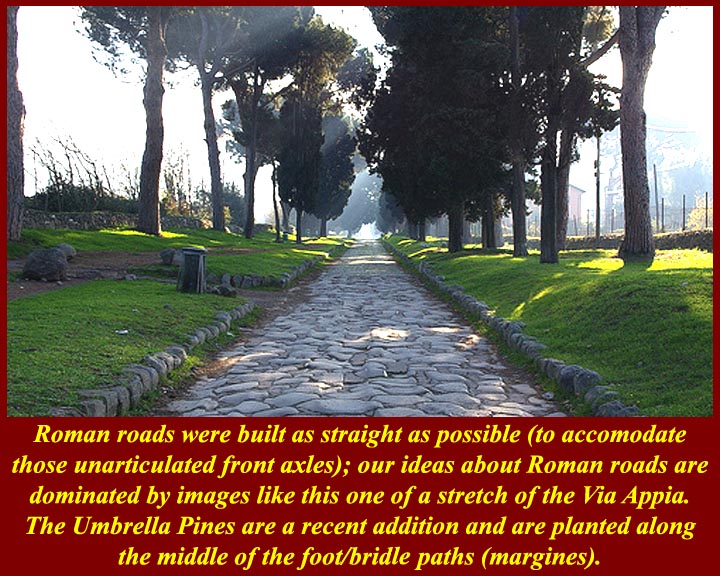
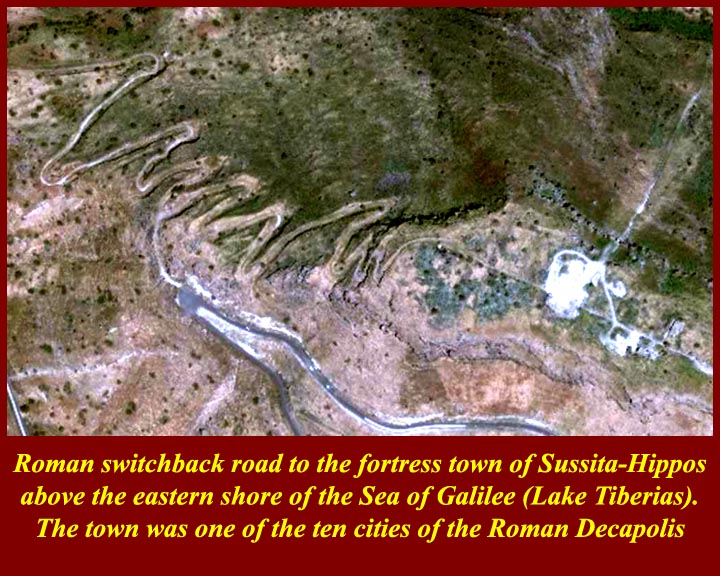
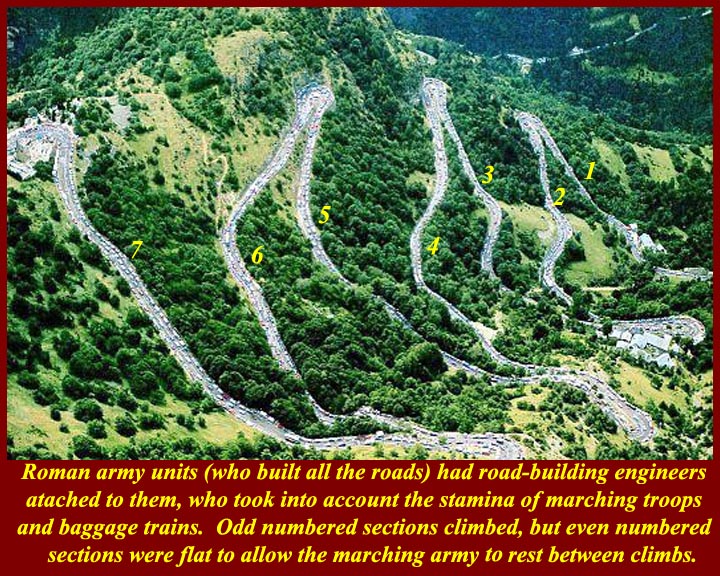
http://www.mmdtkw.org/AU0304fViaApia4.jpg
http://www.mmdtkw.org/AU0304gHipposSwitchbackRoad.jpg
http://www.mmdtkw.org/AU0304hAlpineRoad.jpg
When possible, Roman roads were built straight for long stretches, and that has shaped how we think of Roman roads. The Romans were perfectly capable of building switchback roads, and Roman army engineers took into account the stamina of their troops and of baggage train draft animals by making alternate switchbacks climbing and flat; after climbing on one traverse, the next traverse going the other way would be level to allow for recovery before the next climbing traverse. This pattern is visible in Alpine roads that are built on Roman road foundations and in some areas of the Middle East, such as along the Royal Highway from Amman Jordan to Aqaba, which is also built on a Roman base.
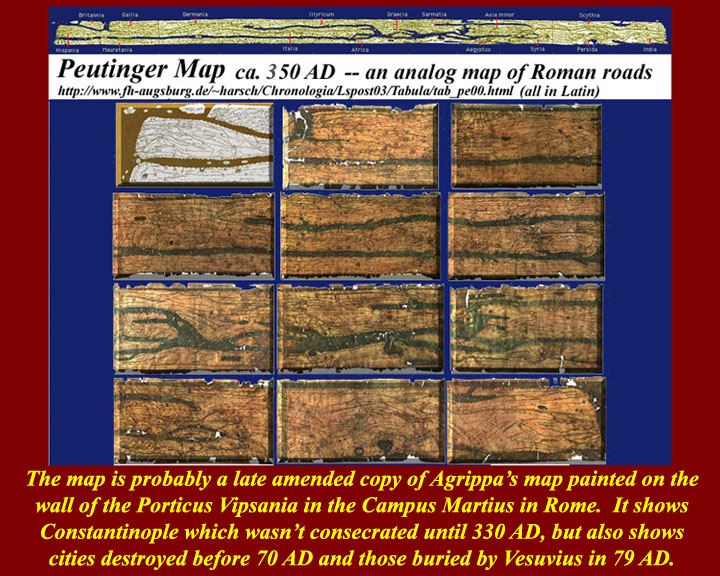
http://www.mmdtkw.org/AU0305aPeutingerMap.jpg
http://www.mmdtkw.org/AU0305bPeutingerMapDetail.jpg
The Peutinger Map (named for its onetime German owner) is generally held to be an amended medieval copy of the map painted on the wall of Agrippa's Porticus Vipsania in Rome's Campus Martius. See also https://www.livius.org/articles/concept/peutinger-map/
http://www.mmdtkw.org/AU0305cPompeiiTombs.jpg
since cemeteries weren't allowed inside the pomeria of cities, the roads just outside the pomeria were often lined with tombs. The ancient Romans believed that a proper burial was necessary in order to allow the ghost of the deceased to rest in peace. For definitions of the various kinds of restless Roman spirits, see http://ancienthistory.about.com/cs/rome/p/lares.htm.
The ancient Roman comedy dramatist Titus Maccius Plautus (c. 254–184 BC), commonly known as Plautus, satirized the Roman belief in ghosts in his play Mostellaria. Mostellaria was one of three plays by Plautus used in the making of the Broadway musical "A Funny Thing Happened on the Way to the Forum" (music and lyrics by Stephen Sondheim and book by Burt Shevelove and Larry Gelbart). Coincidentally, the star of the original Broadway production of "Forum" and of the movie was Zero Mostel.
http://www.mmdtkw.org/AU0305dRomeExpansion.jpg
The need for roads was obvious, and they spread with the Roman sphere of influence. Rome not yet an empire, since there was no Emperor, but Rome was certainly an "imperialist" country. I have a friend whose family owns a major chunk of Louisiana (and offshore oil rights, too). He once told me that his family is not greedy -- they just always want the land that's right next to theirs.
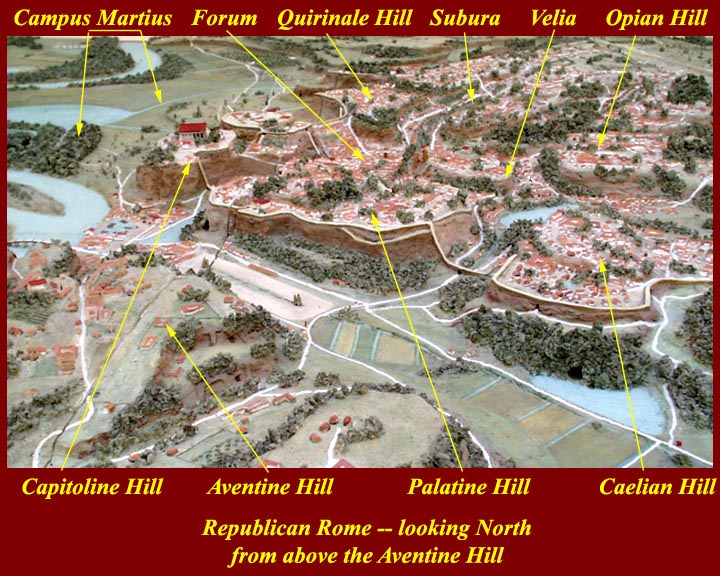
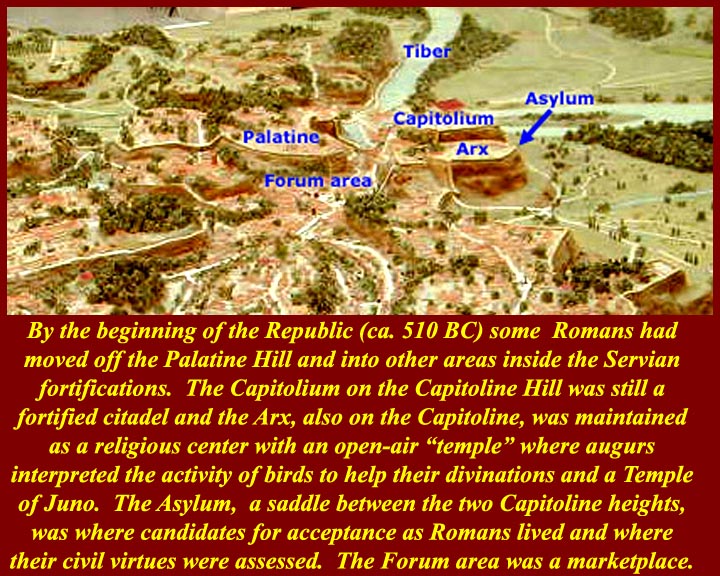
http://www.mmdtkw.org/AU0306aRomaArchaica.jpg
http://www.mmdtkw.org/AU0306bRepublicanRome.jpg
http://www.mmdtkw.org/AU0306cRome4thCentBC.jpg
Rome's hills were really flat topped plateaux, and in archaic and Republican times the sides of the hills were much steeper than what we can see today. For a long time, the Romans kept to their hilltops, which were fortified, but after they had conquered their most immediate neighbors, they got a little careless and started to move down into the valleys between the hills. Those who moved into the less defensible areas were almost always the new arrivals, those who had joined after Rome was already established by the "founding fathers". The images show "Rome spreading from the fortified hilltops, some of which had been taken from neighboring groups, and into the surrounding valleys.
The Latin word for "founding father" was patricius, (plural=patricii), whence "patrician". Senators addressed each other as "conscript fathers", the meaning of conscript here being "adopted", that is conscriptus (con = with + scriptus = written = made a member by adoption, since any adoption into a family or and organization like the Senate was accomplished by the adoptor filing written documents with the censors, who were the keepers of records and arbiters of family and social status).
All those newcomers, who lived in the less defensible valleys between the hills, by the way, were the plebeians or "new arrivals".
Eventually a merchant class arose which was known as the equitati. Originally, that word referred to mounted military, that is, cavalrymen, although we usually refer to them as knights or equites. The key factor was that the equitati were non-patricians who supplied and fed their own horses (and grooms and squires, etc.) or who could do so if necessary in times of military crises. This required more money than a run-of-th-mill plebeian was likely to have. (Those Patricians who served as mounted military officers were mounted on "government horses" provided by the state.)
Inevitably, the various classes were simply associated with levels of wealth, and if you accumulated enough wealth (and "the right way") you could move up through the class structure. You didn't exactly buy your way in, but the censors had to attest that you actually had the wealth. The right way to get wealth for a Patrician was through land ownership whether acquired or inherited (rents, sale of crops -- handled of course by others -- etc.) You also had to have a certain amount of money to be a knight, and knight money could be acquired by commerce. Patricians never overtly participated in commerce -- you would hire a knight to do that.
Plebeians could get rich any way they wanted to, but it was hard to get enough money to become a knight, unless you did something special for your patron then who might just hand you enough cash to move you up.
This was all further complicated by the status of freedmen -- former slaves. During the Republic, they could not move up, but their sons were full Roman citizens by birth with all the opportunities available to other Roman citizens. Slaves could acquire wealth and buy their own freedom or they could be manumitted by their masters or at the death of their masters.
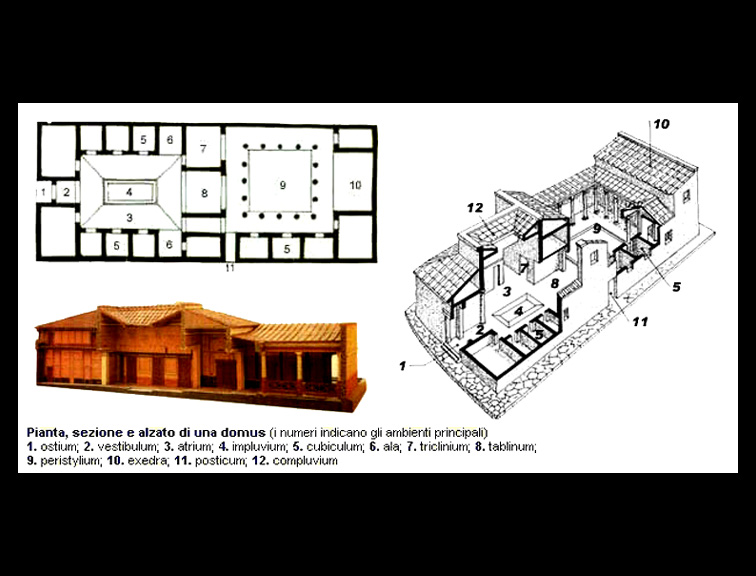
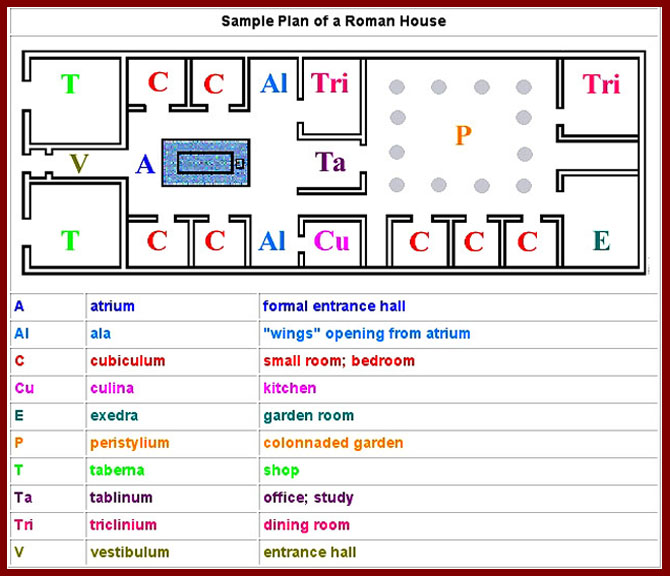
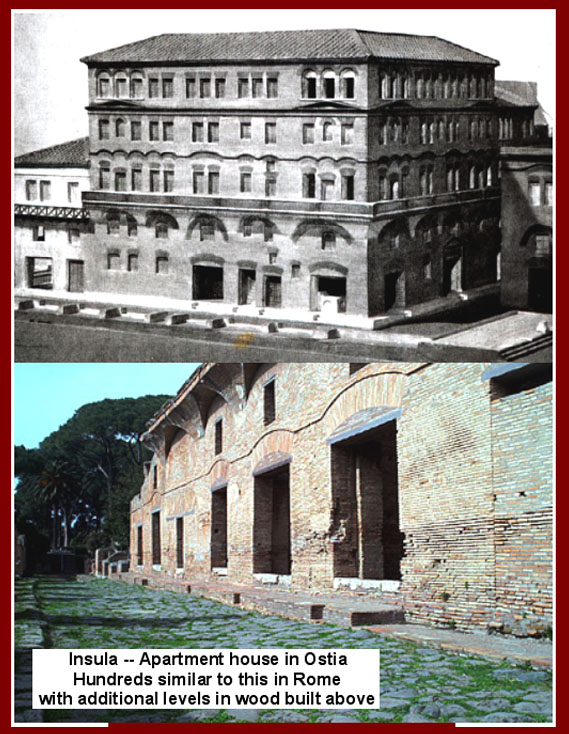
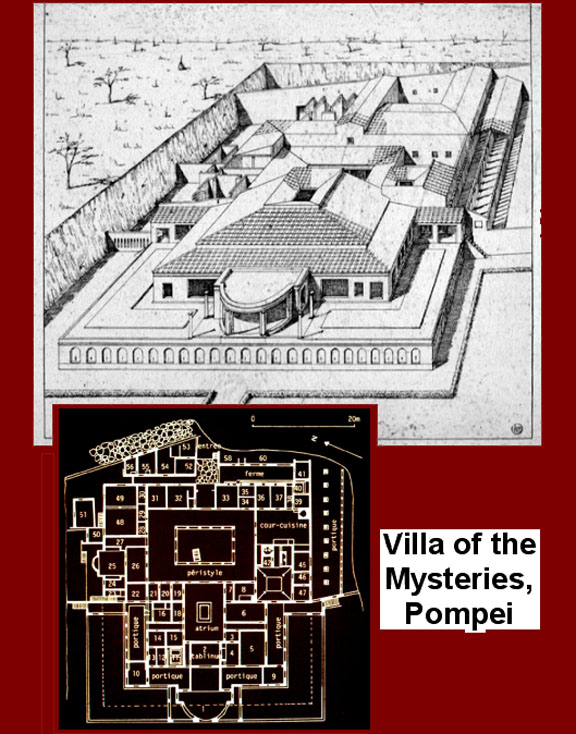
http://www.mmdtkw.org/AU0306dDomus.jpg
http://www.mmdtkw.org/AU0306eRomanHousePlan.jpg
http://www.mmdtkw.org/AU0306fInsula.jpg
http://www.mmdtkw.org/AU0306fVillaMysteries.jpg
Every Roman householder aspired to own a "domus", and a more wealthy one might live in an atrium domus, a style derived from similar homes of the Etruscans.
Most Romans, however, lived in insulae. Except for the most exclusive neighborhoods the city was aswarm with apartment dwellers. An insula usually had three or four brick levels and was routinely topped with a rickety wooden structure that could go several stories higher. Where the insula faced a street or streets, there were almost always shops and fast-food outlets, which often had rear apartments for the shopkeepers or shop managers. The biggest, best, and most expensive apartments were on the floor directly above above the shop level with comfort and status decreasing as levels got higher. The worst and cheapest apartments were in the wooden superstructures.
Fire was always feared; although few people cooked in their digs, all lighting used open flames. Streets were narrow in the insulae neighborhoods and the "vigiles" (firemen/watchmen) had a hard time getting their pumps and equipment to the scene of a fire, and even then, there might not be sufficient water. Fires spread rapidly from one building to the next, and casualty rates in the upper floors were always high; there were no fire-escapes or fire-fighting platforms on the high buildings (5-8 floors) until Nero forced through laws mandating them after the fire for which he is so famous.
Really rich folks might have a suburban villa outside the walls.
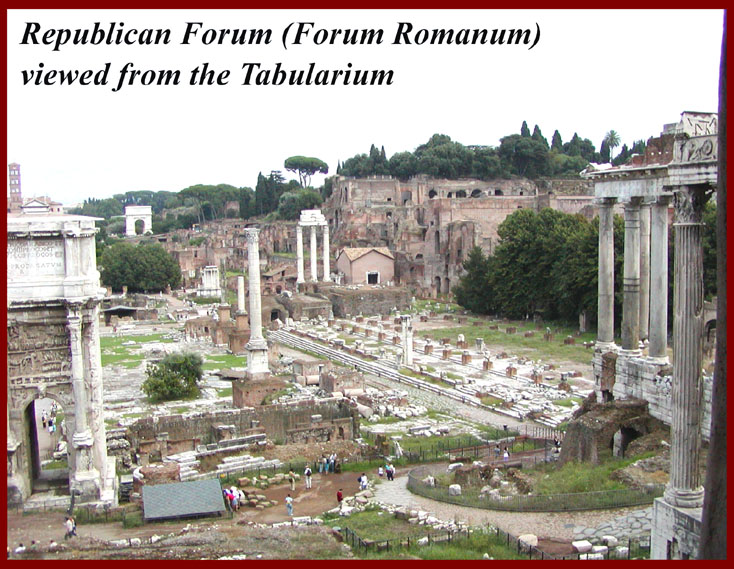
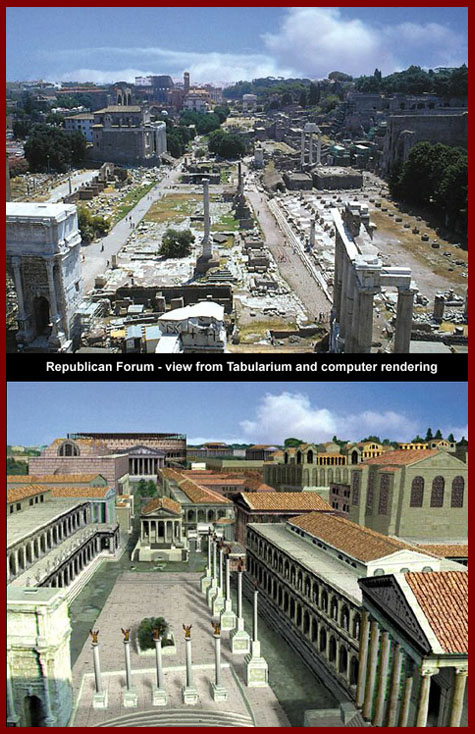
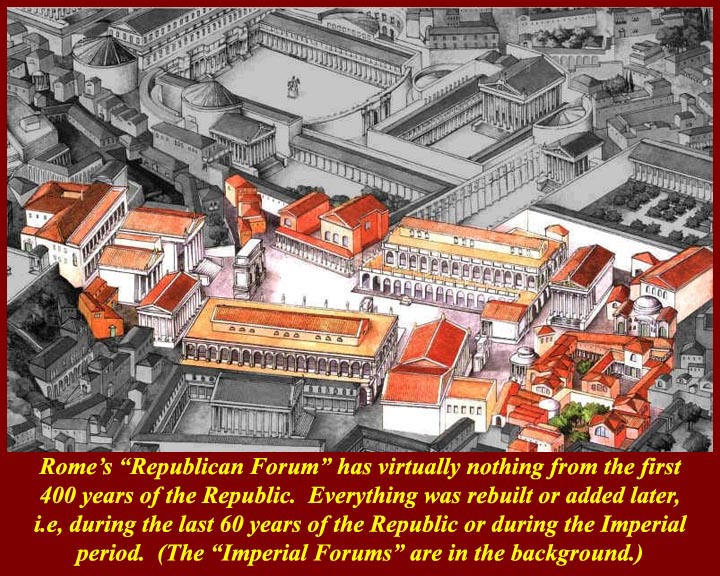
http://www.mmdtkw.org/AU0306hForumfromTab.jpg
http://www.mmdtkw.org/AU0306iRepForum.jpg
http://www.mmdtkw.org/AU0306jcRepublicanForum1.jpg
http://www.mmdtkw.org/AU0306kVelia.jpg
The Forum was the civil, religious, social, and commercial center of the city. What is visible in the "Republican Forum" (AKA Forum Romanum) is almost entirely from the last fifty years of the Republic or from later periods. There were contiguous "imperial forums" which will be covered in a later unit. The first part of the forum area to be developed, during the monarchy, was the Velia, a low ridge that ran between the Palatine. and Opian Hills. The Velia was dry enough for construction of temples as the Capitoline became overcrowded. Some civil structures soon were added at the opposite (western) end of the forum on the slopes of the Capitoline. After the Etruscan Tarquin kings built the cloaca maxima and drained the low center of the forum, it was quickly taken over by commercial activities. By the middle of the Republican period, religious structures expanded westward from the Velia and civil activity spread eastward from the Capitoline slopes. Commercial activity was pushed out of the forum and toward the Tiber River port area. In the last fifty years of the Republic, virtually everything in the forum was rebuilt on a much grander and more costly scale.
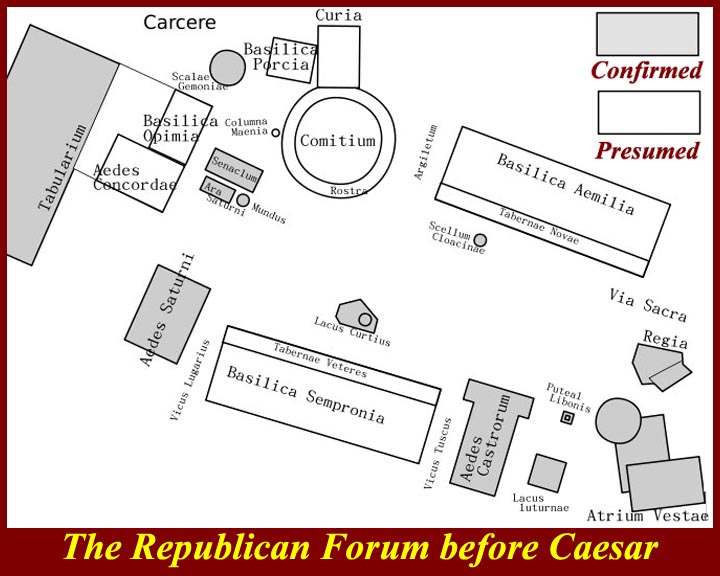
http://www.mmdtkw.org/AU0306lForumBeforeCaesar.jpg
http://www.mmdtkw.org/AU0306mForumAfterCaesar.jpg
When referring to the Republican Forum, BC means before Caesar. Using money he stripped from Gaul, he launched major projects in the forum. Among the most important project (but not the biggest) was the building of a new Senate meeting house (curia) to replace the Curia Hostillia that was built by Tulius Hostillius, Rome's third king. The Curia Hostillia had been burned down during a riot in 52 BC. The new Curia, called the Curia Julia after Julius Caesar, was actually completed after his death by Augustus. The Forum of Caesar, the first of the Imperial Forums was directly behind the Curia Julia and was also started by Julius Caesar and completed by Augustus.
http://www.mmdtkw.org/AU0306nForumPlanWithKey.jpg
A map of the "Republican" forum ruins.
http://www.mmdtkw.org/AU0306oForumRomanum300AD.jpg
An artist's conception of the Western end of the Republican Forum. The large structure in the background on the slope of the Capitoline is the Tabularium, The Roman state archives, where the Twelve Tables and other other important state documents were kept. The artist has added some color to the marble and travertine structures, but not nearly enough to reflect reality.
http://www.mmdtkw.org/AU0306pMetaSudans.jpg
At the far eastern entrance of the forum, on the back side of the Velia near the big pond where the Colosseum now stands, was the fountain called the Meta Sudans (= sweating cone). It marked the place where triumphal parades turned to enter the Sacra Via (= sacred road) that ran through the forum and then up the Capitoline to the temple of Jupiter Optimus Maximus (= Jupiter the best greatest).
Jupiter shared his temple with Juno and Minerva, and together the three were known as the Capitoline Triad. All Roman cities would build a temple to the Triad (although such temples are now simply called temples of Jupiter) as testimony to their loyalty to Rome. The Triad temple was always the center of Roman "old time religion".
Jupiter, by the way, is thought to be a corruption of "Zeus pater" = "the father god". Zeus (Latin deus, Greek Theos) simply meant "a god", and without a qualifier, like "pater" it meant very little. The feminine form was dea. The confusion of initial sounds in zeus, deus, theos, and Jupiter results from the fact that all four initial sounds derive from the same archaic alphabet letter/sound, which still exists in Arabic but has disappeared from other Mediterranean alphabets.
http://www.mmdtkw.org/AU0306qVestaCastor.jpg
In the Republican Forum, the remains of the Temple of Vesta stand next to three re-erected columns and part of the architrave and frieze of the Temple of Castor and Pollux. The originals of both temples dated from the Monarchy, but what is seen now dates from the Imperial period. The Temple of Vests was probably originally a round or almost round wooden and thatched hut, like those in the first settlement on the Palatine. The Vestal priestesses maintained the sacred hearth fire, which was supposed to be kept lit perpetually and from which individual hearth fires would be kindled. Needless to say, the Vestal temple burned to the ground and was rebuilt on many occasions. The remains seen today appear to be from the 2nd century AD.
(a)(b)
http://www.mmdtkw.org/AU0306rCuriaForum.jpg
http://www.mmdtkw.org/AU0306sCuriaPompey.jpg
(a)The Curia Hostillia is where the Senate met until it was burned down in the 52 BC riot after the death of Clodius (unit 5 will discuss this.) In front of the Curia Hostillia was the comitium where the general population met for discussion/explanation of laws passed by the Senate and annual voting for magistrates. The second image (b) shows the curia built by Pompey at the back end of the big quadriporticus (= four-sided pillared courtyard) behind his theater as a temporary meeting place for the Senate after the fire of 52 BC. It was on the front porch of this curia that Julius Caesar was killed -- at the base of the statue of Pompey, his old enemy -- in 44 BC. See http://penelope.uchicago.edu/Thayer/E/Roman/Texts/secondary/SMIGRA*/Curia.html for curia and http://penelope.uchicago.edu/Thayer/E/Gazetteer/Places/Europe/Italy/Lazio/Roma/Rome/_Texts/PLATOP*/Comitium.html for the comitium.
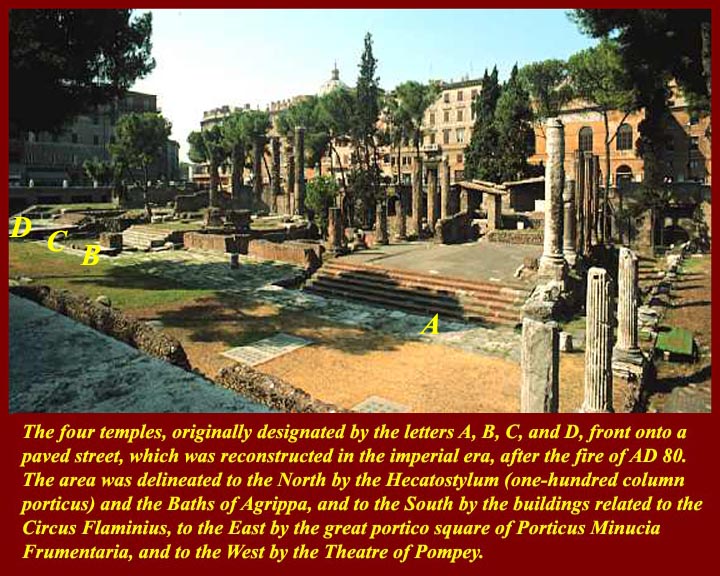
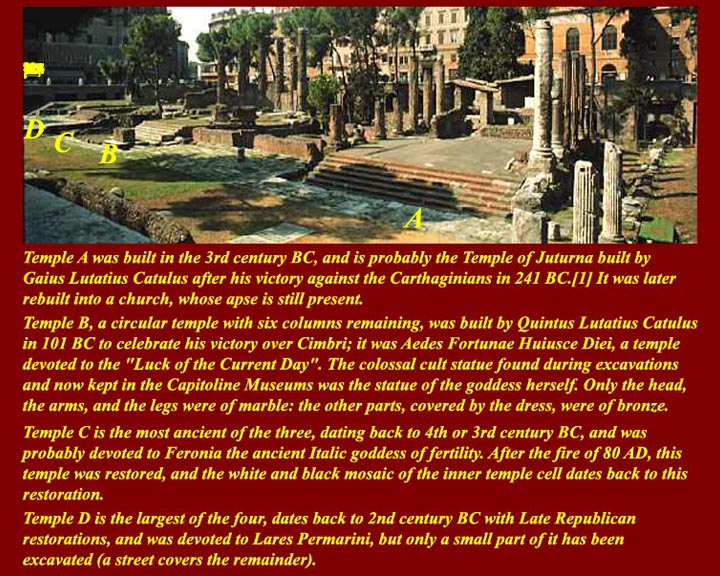
http://www.mmdtkw.org/AU0306tLargoArgentinaA--D.jpg
http://www.mmdtkw.org/AU0306uLargoArgentinaABCD.jpg
http://www.mmdtkw.org/AU0306vLargoArgentina.jpg
Directly behind Pompey's curia were a group of four republican temples, the remains of which are visible today in an open excavation in Rome's Piazza Argentina. Piazza Argentina is named after Johannes Burckhardt; see http://www.mmdtkw.org/VBurcardo.html.
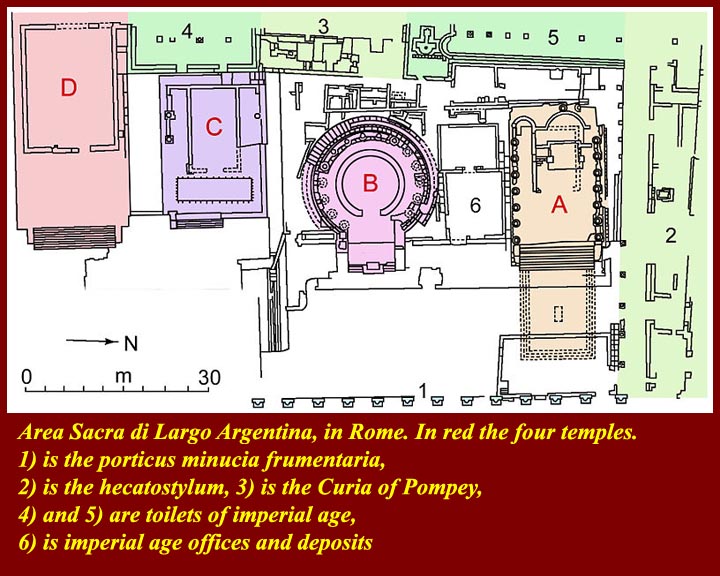
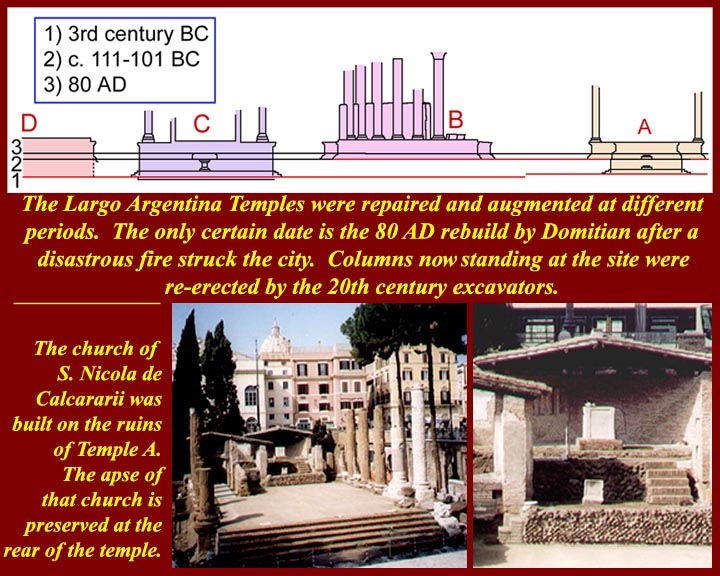
http://www.mmdtkw.org/AU0306wLargoArgentinaPlan.jpg
http://www.mmdtkw.org/AU0306xLargoArgentinaAltitude.jpg
http://www.mmdtkw.org/AU0306yLargoArgentinaSNicola.jpg
The Piazza Argentina Temples diagrammed.
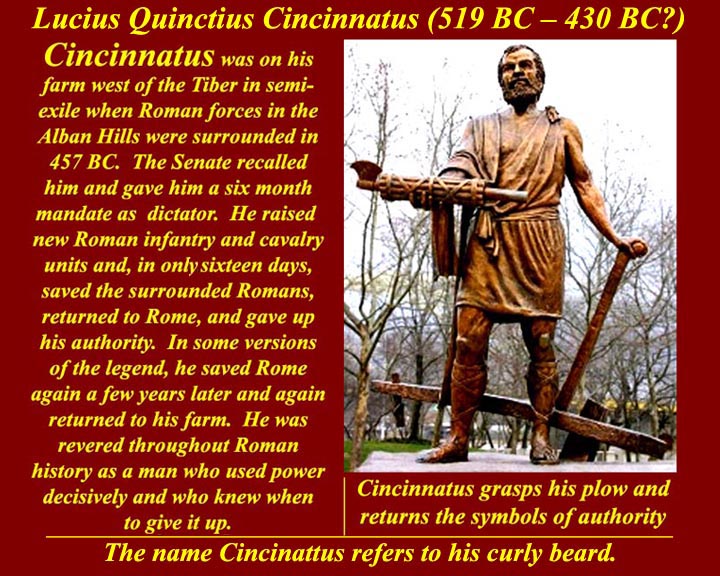
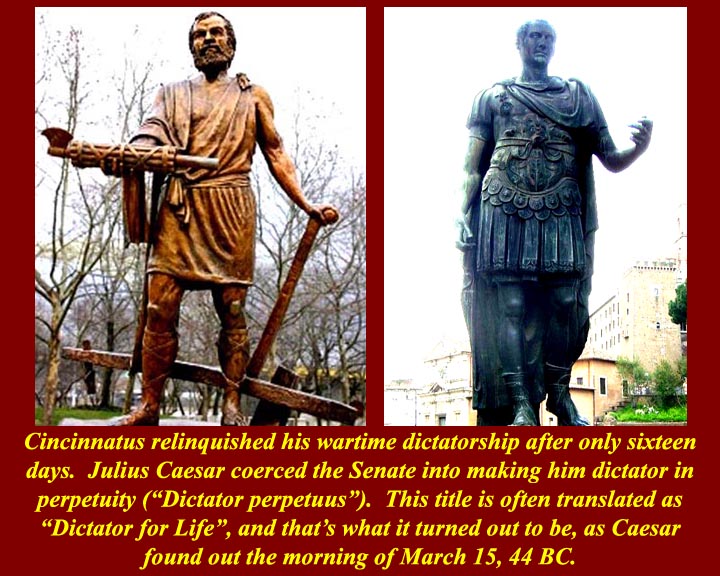
http://www.mmdtkw.org/AU0307aCincinnatus.jpg
http://www.mmdtkw.org/AU0307bCincinnatusCaesar.jpg
http://www.mmdtkw.org/AU0307cCincinnatusWashington.jpg
Among the semi-mythical defining actors in the early Roman Republic was Cincinnatus, who had been a Roman Magistrate and then was discredited by a later regime. In 457 BC he was recalled by the Senate and made dictator to rescue a Roman "army" (we don't know how many, but it would have been small) that had been surrounded in the Alban Hills southeast of Rome.
Cincinnatus raised new forces, extricated his countrymen, and defeated the enemy. He was back in Rome victorious in just sixteen days, and there he gave up his dictatorial powers and returned to his farm. This was held up as an ideal for Roman authority figures. See http://en.wikipedia.org/wiki/Cincinnatus.
Julius Caesar, some 400 plus years later coerced a tamed and packed Senate into making him "perpetual dictator" -- he clearly did not live up to the Cincinnatus ideal and paid for his hubris with his life.
George Washington, after his success as an American Revolution military leader, actively sought to portray himself as a "Cincinnatus" who quickly had returned to his agrarian life at Mt. Vernon. He and many of the officers that served under him formed the "Society of the Cincinnati" (which still exists today), which many historians say was the motivating force behind a thinly disguised effort to end the confederal government and establish a new constitution and federal system of government with Washington and his cronies as leaders.
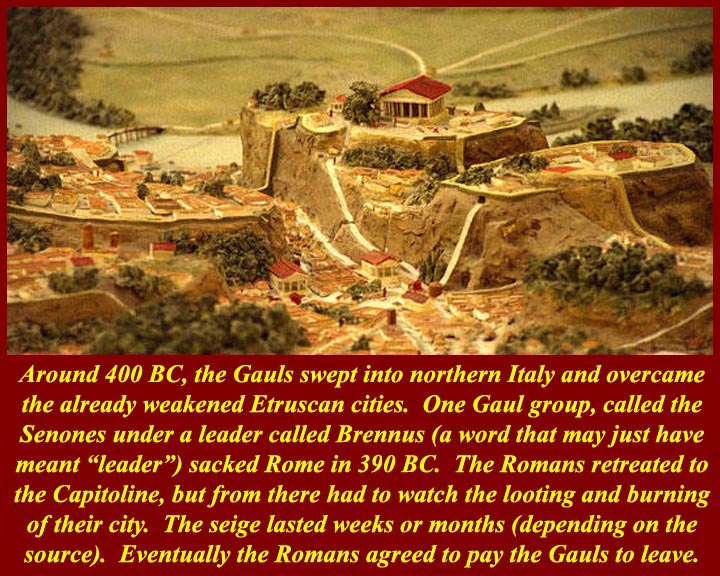
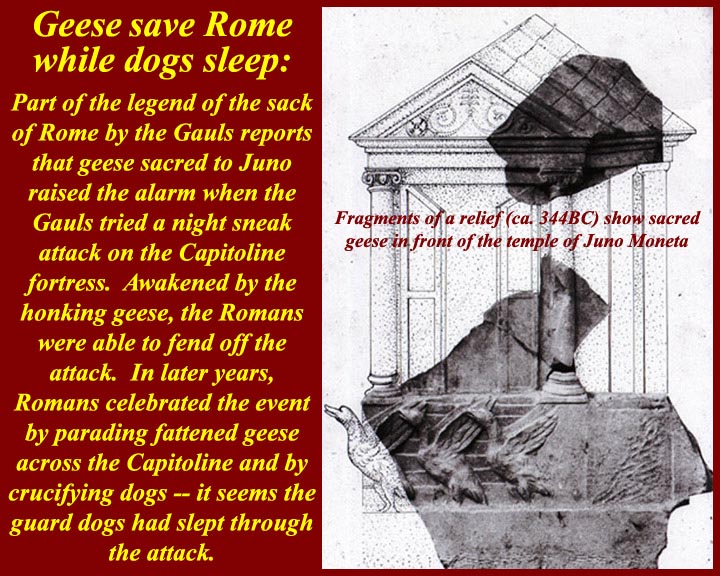
http://www.mmdtkw.org/AU0308aRomansBesiegedByGauls.jpg
http://www.mmdtkw.org/AU0308bJunoMonetaGeese.jpg
http://www.mmdtkw.org/AU0308cJunoMonetaTemple.jpg
Around 400 BC, the Gauls, under pressure from their northern and eastern neighbors, crossed the Alps into Italy and began to settle in what became known as Cisalpine Gaul (cisalpine meant "this side -- south -- of the Alps", transalpine meant "other side of the Alps"). They were able to do this, because the Romans had already severely weakened the Etruscan cities that would have served as a buffer for the Romans. In 390, a group of Gauls called the Sennones under a leader called "Brennus" (that name also might just have meant "leader") sacked most of Rome while the Roman aristocracy retreated to the fortified area around the Temple of Jupiter on the Capitolium heights of the Capitoline hill.
Eventually the Gauls were bought off -- or perhaps they were fought off -- or perhaps they just took what they wanted and left. It's all fraught with myth and legend.
Two complimentary stories emerged much later. One was that the geese that were kept at the temple of Juno Moneta on the other peak of the Capitoline, the Arx, alerted the Romans to let them intercept and drive off some Gauls who were sneaking up onto the Capitoline to massacre the Romans. Guard dogs, according to the legend, slept through the whole episode. Many historians view this story as an attempt to explain/justify the annual ancient Roman festival that paraded geese around Capitoline Hill accompanied by crucified dogs. Roman barbarisms based on ancient pre-Roman rites where usually explained by some myth or another. (The Roman mint was eventually installed in the basement of the Juno Moneta temple. The Latin word "moneta" originally meant "preserver", so the temple on the Arx was dedicated to Juno the preserver/protectress of Rome. After the mint was installed, "moneta" acquired a secondary meaning associated with money. Our words "mint", "monetary", even "money" itself, etc., are all derived from "moneta" in its secondary meaning.)
The second story, also heavily questioned by historians, is that "Brennus" agreed to lead his Gauls away only if the Romans on the Capitoline would pay him 1000 pounds of pure gold. He compounded his peculation by using false weights on the scales. When the Romans objected, he, according to legend, threw his heavy sword on the scales with the false weights and shouted "woe to the defeated". This roused the Romans to action: they refused to pay the ransom and drove off the Gauls.
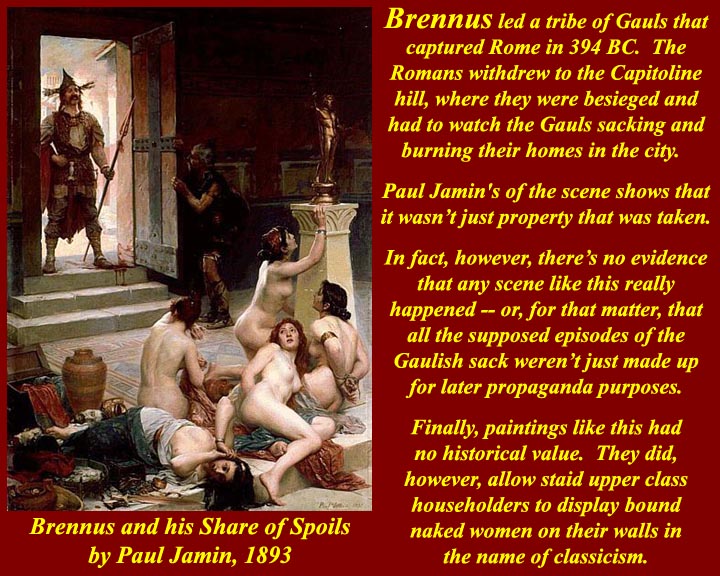
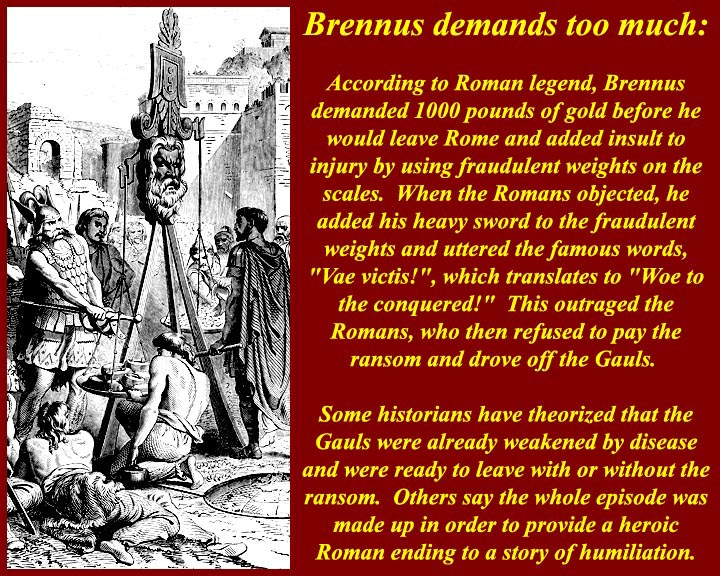
http://www.mmdtkw.org/AU0308dBrennusSpoils.jpg
http://www.mmdtkw.org/AU0308eBrennusGold.jpg
http://www.mmdtkw.org/AU0308fDyingGaul.jpg
After the Gauls sacked Rome, they became Rome's perpetual bogeymen. They told their kids to behave or the Gauls would get them -- and they really believed it. This made it easy for Caesar to justify his later looting and genocide against the Gauls.
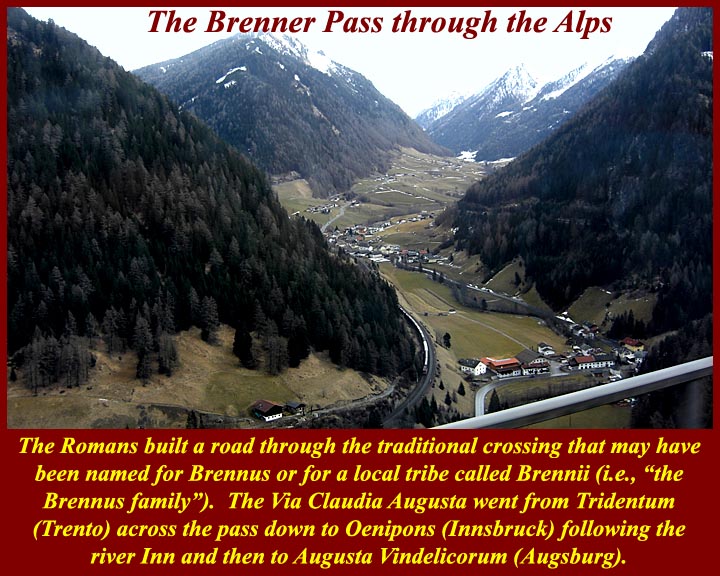
http://www.mmdtkw.org/AU0308gBrennerPass.jpg
http://www.mmdtkw.org/AU0308gBrennusFrenchMaritimeSculpture.jpg
While Brennus was evil personified to the Romans, he was a hero to transalpine people.
http://www.mmdtkw.org/AU0309aCarthageSicily.jpg
Rome's next nemesis was Carthage. The Carthaginians were the rump of the Phoenician trading empire in the Mediterranean; they took over the Phoenician mantle when Phoenicia itself fell to its eastern neighbors. The Carthaginians had established themselves on Sicily and controlled the relatively narrow sea passage between Sicily and North Africa. Rome wanted to trade through that passage, and from about 500 BC onward Rome and Carthage had an unequal treaty through which Carthage allowed Roman trade. Rome was clearly the underdog in this arrangement. The Greek (Magna Graecia) colonies along the coasts of southern Italy and Sicily were third party in the uneasy equation.
To make a long story short, the Greek colonies on Sicily, under military threat from the Carthaginians, hired the mercenary army of Pyrrhus of Epiros to fight the Carthaginians. Pyrrhus was the first to use elephants in war in the Mediterranean. The Romans had been moving down the Italian peninsula, and Pyrrhus saw the opportunity to grab some Roman turf on the Italian mainland. Pyrrhus won all the battles against the Romans, but lost the war because, unlike the Romans, he was unable to replace his casualties. After the defeat of Pyrrhus, some of the Roman forces were feeling confident and crossed the straights of Messina and took over a local Sicilian fortress. The locals asked for Carthaginian help in removing the Romans, and the Romans appealed for help from their homeland. The First Punic War between Rome and Carthage had begun. The Punic Wars are the subject of the next unit, and there you will get the long story version of this short one.
http://www.mmdtkw.org/AU0309bPolybius2.jpg
How do we know what we know about the Punic Wars? The Greek Historian Polybios (Latinized as Polybius) wrote about them, and, because of his position as hostage/houseguest/protege and adopted grandson of Scipio Africanus the Elder, and, as the former tutor and, later, accompanying battle historian of Scipio Africanus the Younger, he either was present at the action or was able to interview the participants. He even had access to the losing Carthaginian officers including Hannibal. Just by luck, a copy of his history survived almost intact. An English translation is available at http://penelope.uchicago.edu/Thayer/E/Roman/Texts/Polybius/home.html.
http://www.mmdtkw.org/AU0309caPunicScoreCard.jpg
The Romans won all three wars against the Carthaginians.
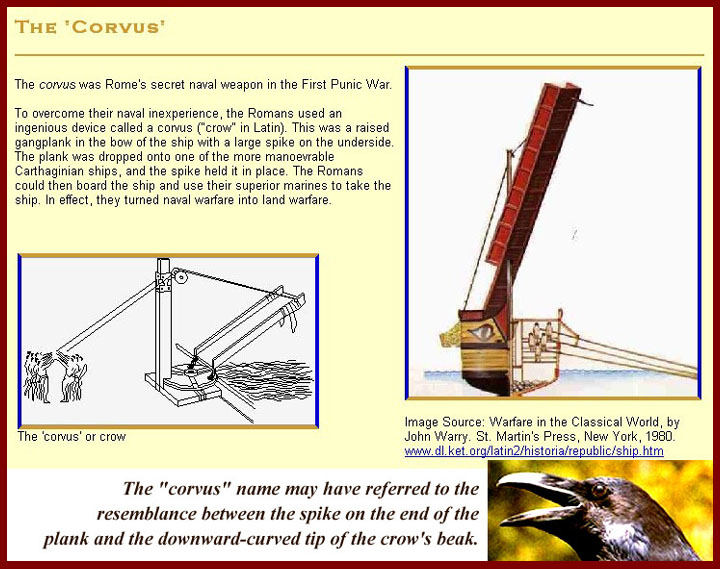
http://www.mmdtkw.org/AU0309cb1stPunicCorvus.jpg
http://www.mmdtkw.org/AU0309d1stPunicCorvusToCatapult.jpg
The First Punic War was mostly fought at sea. Carthage initially had the advantage; the Romans didn't even have a fleet, much less men who knew how to man ships. What the Romans did have was money they were willing to spend -- the Carthaginians had money too, but they were penny-pinchers. The Romans built or bought ships, trained men, and, despite heavy losses due to inexperience, bad navigation, and storms, achieved and thereafter maintained a naval advantage. The Romans also had a technological advantage. They invented the well known "corvus", a Ramp that could be used to move Roman land troops onto the decks of Carthaginian ships. The corvus ramps made the Roman ships top-heavy and difficult to maneuver, and they was quickly supplanted by catapults that fired heavy barbed darts attached to a short mast by a chain. Enemy ships could be reeled in and troops would scramble across to defeat the enemy crew. So many ships were captured this way that the Romans could stop their own ship-building activities. The Romans soon controlled the seas and the Carthaginians sued for peace, agreeing to pay a huge indemnity, and leaving their General, Hamilcar Barca (the father of Hannibal) stranded with his troops in Sicily. Hamilcar also eventually cut a deal with the Romans and brought home his troops. The Carthaginian government refused to give Hamilcar's troop wages and bonuses that had been promised, and a Carthaginian civil war ensued. The eventual outcome of that was that the Carthaginians lost Sardinia and Corsica to the Romans (and that's where the Carthaginians had cut wood for shipbuilding) and, in addition, Carthage had to give the Iberian peninsula, one of the richest areas of the Carthaginian sphere of influence, to the Barca Family to get the embittered Hamilcar away from the capital. It was from Barcid Iberia that the next Punic war was launched.
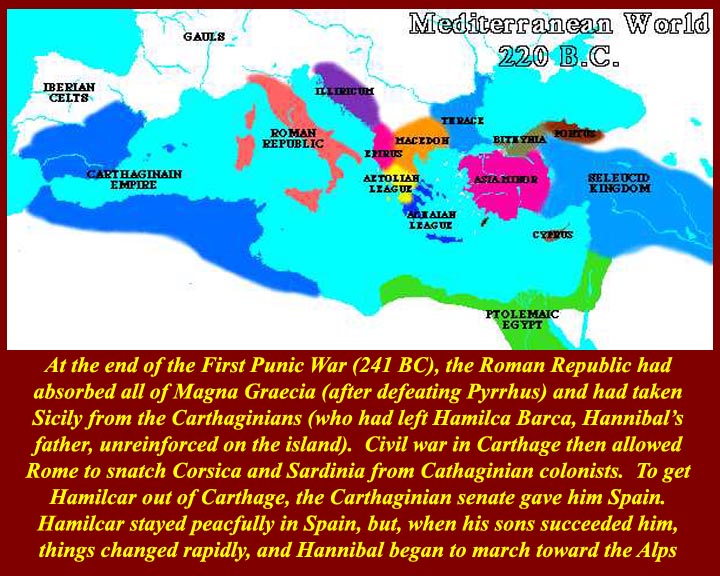
http://www.mmdtkw.org/AU0309e220MED.jpg
http://www.mmdtkw.org/AU0309f218WMED.jpg
Maps showing Roman and Carthaginian holdings in the Mediterranean just before the Second Punic War, and the major engagements and marches of the Second Punic War.
http://www.mmdtkw.org/AU0309g2ndPunicRhoneElephants.jpg
After the death of Hamilcar in Iberia, his son, Hannibal, took a much more militarist position. He threatened and temporarily took the coastal city of Saguntum, an ally of Rome, and shortly thereafter began his march toward the Alps. He lost tens of thousands of men and most of his supplies going through the Pyrenees and the Alps -- perfidious guides, hostile tribes, and the weather all contributed to the losses. He straggled down the Italian side of the Alps with only a fraction of the army that he had mustered at New Carthage in Iberia. Nonetheless, using the troops he had, local recruits, and reinforcements of men and elephants that arrived by sea, he had some notable victories in the first year or two of the war.
http://www.mmdtkw.org/AU0309h2ndPunicHannibalRoute.jpg
Hannibal's rout through the Alps is one of those things historians love to debate. Polybius' account gives a day by day account of the passage through the mountains derived from interviews with participants. He includes descriptions of terrain, but he doesn't give place names -- there may not have been agreed place names, and even if there were, it would be very hard to transfer them to modern place names. Also, despite the fact that many thousand men and huge piles of military equipment fell by the wayside, nothing has been found anywhere that would indicate the passage of Hannibal's army; local mountain tribesmen would have scavenged anything left behind, and innumerable earthquakes and avalanches could have buried anything they didn't take. There is a fairly well agreed "most likely route" but the details are lacking. Every year, several new doctoral dissertations provide new theories of where Hannibal marched.
See https://www.livius.org/sources/content/hannibal-in-the-alps/ for the descriptions of Hannibal's march through the alps by Polybius and the more derivative Livy.
http://www.mmdtkw.org/AU0309i2ndpunicwar.jpg
Despite his heavy losses in the mountains, Hannibal, using the troops he had left, local recruits, and reinforcements of men and elephants that arrived by sea, had some notable victories in the first year or two of the war. He outsmarted and outfought all the Roman generals in big pitched battles at the beginning of the war, but it was Pyrrhus all over again. After their initial defeats, the Romans simply refused to fight pitched battles. Roman armies were broken up into smaller units that ran in behind the Carthaginian column, retaking whatever had been lost. Roman garrisons were put in cities and towns, while Hannibal's large army was forced to be constantly on the move simply to keep itself supplied; it was too big to live off the land in any place for any great length of time. The Roman field commander, Quintus Fabius Maximus Verrucosus (ca. 280 BC-203 BC), was called Cunctator (the Delayer), because he devised what are still taught in the world's War Colleges as delaying "Fabian Tactics". Hannibal marched around Italy for the next 15 years and never had another great victory. Meanwhile his army was eroding and Carthage, once again, was not willing to spend money or send troops to reinforce him. An attempt by Hannibal's brother Hasdrubal was thwarted at the Battle of Metaurus. Meanwhile, Scipio (later Africanus the Elder) was wreaking havoc in Barcid Spain. Eventually Scipio led the Roman expeditionary force into North Africa. Carthage recalled Hannibal to fight Scipio and the ultimate battle was fought at Zama. Just before the Battle, Masanissa a leader of the Numidian cavalry, switched allegiances and fought on the side of the Romans rather than on the side of Carthage. The battle was over in a few hours with Rome the victor.
http://www.mmdtkw.org/AU0309j2ndPunicZamaBattleMap.jpg
Battle order at Zama, October 19, 2002.
http://www.mmdtkw.org/AU0309kHannibalSuicide183BCh.jpg
The upshot of the battle was that Scipio now had control of Carthage, and one of the first things he did was to install Hannibal as city Governor. Hannibal was embittered, just as his father had been, and was willing to take the city over from the Carthaginian Senate. It soon became apparent to him, however, that he would be kept on a very short rein and that the Roman peace conditions were intolerable. in 195 BC, he left town and joined with some of Rome's other enemies around the Mediterranean. He fought one more battle against the Romans, defeating them as the admiral of a Bithynian fleet, but eventually committed suicide in 183 BC to avoid being turned over to the Romans.
http://www.mmdtkw.org/AU0309lRomeFactionsCato-Scipios.jpg
Meanwhile, back in Rome, Scipio Africanus celebrated his triumph, but was under attack from political enemies, who rightly feared his rising power. The Senate had refused him permission to lead the expeditionary force to North Africa so he had taken the issue directly to the people. When he began to organize his own expedition, the Senate had refused to give him troops or money. He went anyway, using his own money and mustering the veterans of the Battle of Canae who had been sent in disgrace to Sicily. When he came back victorious, he was attacked on many fronts, especially by a Senate faction led by Cato the Elder. Scipio refused to defend himself against civil suits and eventually left Rome for self imposed exile on his country estate at Liternum on the coast of Campania where he died, probably in 183 BC. In his will he asked to be buried in Liternum rather than in the family tomb on the Via Appia. We'll pick up this thread again, adding more detail, after quickly running through the events of the Third Punic War.
http://www.mmdtkw.org/AU0309m3rdPunicYoungerScipio.jpg
The younger Scipio, Publius Cornelius Scipio Aemilianus (185 - 129 BC) was a leading general and politician of the ancient Roman Republic. As consul he commanded at the final siege and destruction of Carthage in 146 BC, and was a leader of the senators opposed to the Gracchi in 133 BC.
He was born the younger son of Lucius Aemilius Paulus Macedonicus, the conqueror of Macedonia, and fought when he was 17 years old by his father's side at the Battle of Pydna, which decided the fate of Macedonia and made northern Greece subject to Rome. He was adopted by Publius Cornelius Scipio, the eldest son of Publius Cornelius Scipio Africanus, and his name was changed to Publius Cornelius Scipio Aemilianus.
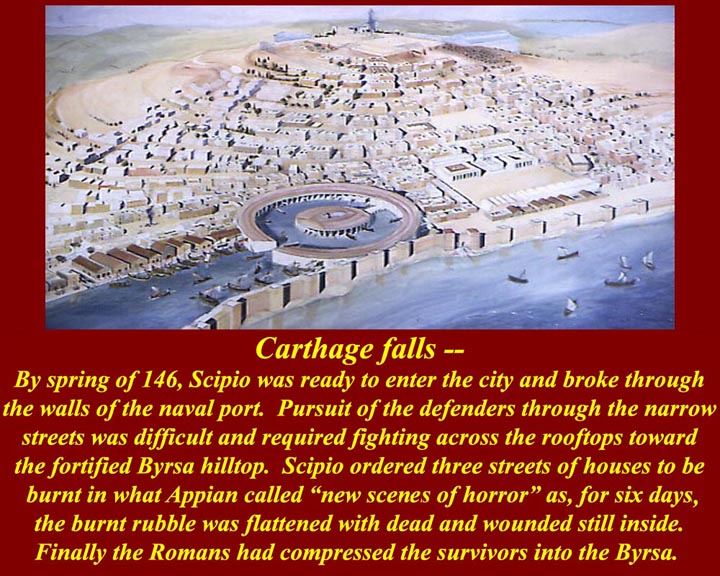

http://www.mmdtkw.org/AU0309n3rdPunicCarthageFalls.jpg
http://www.mmdtkw.org/AU0309o3rdPunicCarthageCasualties.jpg
http://www.mmdtkw.org/AU0309p3rdPunicCarthageDestroyed.jpg
In 151 BC, a time of disaster for the Romans in Spain, the younger Scipio voluntarily offered his services in that province and developed an influence over the native tribes similar to that which Scipio Africanus, his grandfather by adoption, had acquired nearly 60 years before.
In the next year an appeal was made to him by the Carthaginians to act as mediator between them and the Numidian prince Massinissa, who, supported by a party at Rome, was incessantly encroaching on Carthaginian territory. The mediation failed, and, in contravention of the treaty that had ended the Second Punic War, the Carthaginians took action against Masanissa.
In 149 BC Rome declared war once again on Carthage, and sent a force to besiege the city. In the early operations of the war, which went altogether against the Romans, Scipio Aemilianus, though a subordinate officer, distinguished himself repeatedly, and in 147 BC he was elected consul by popular acclaim (and over the objections of the anti-Scipio faction in the Roman Senate). Scipio was under the legal age but was elected anyway so that he could be given the supreme command of the North African expeditionary force . After a year of desperate fighting and splendid heroism on the part of the defenders he conquered Carthage, and at the Senate's bidding leveled it to the ground. In 146 BC "Scipio the Younger", as he was known, razed Carthage to the ground, ending the Third Punic War. On his return to Rome he celebrated a splendid Triumph, having also established a personal claim to his adoptive agnomen of Africanus.
The treaty with Rome had required that Carthage seek Roman permission for any military activity and to remain disarmed. Some historians have said that the Roman attack on Carthage was unjustified and simply a way of seizing territory, which eventually would pass into the hands of rich Roman landholders.
As it turned out, it was obvious from what was captured in the military port of Carthage that the Carthaginians were, in fact, violating the treaty by stockpiling parts of ships that could be quickly assembled into a large battle fleet. It is not clear that the Carthaginian Senate was aware of that fact. There was a war party in Carthage that, in association with the Carthaginian military-industrial complex, might have taken over and made aggressive war against Rome.
Scipio the Younger is said to have wept on seeing the destruction of Carthage, not in sympathy for the tens of thousands of dead or enslaved Carthaginians, but because he foresaw that Rome would also eventually be destroyed.
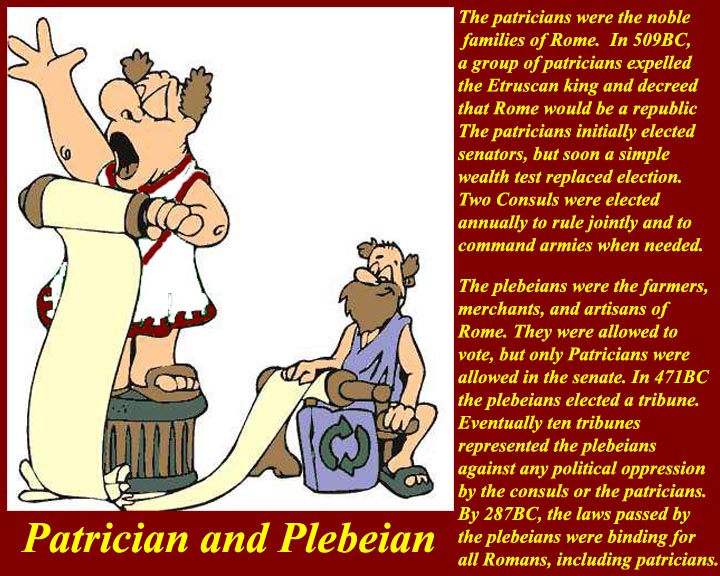
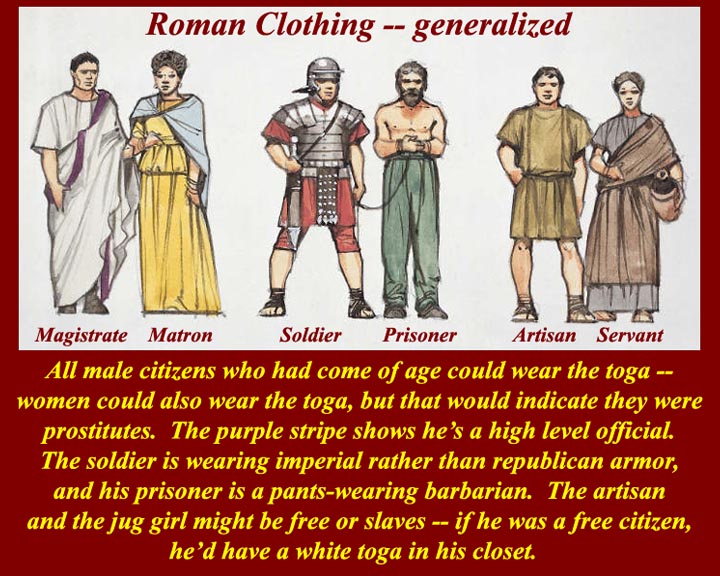
http://www.mmdtkw.org/AU0310aPatricianPlebeian.jpg
http://www.mmdtkw.org/AU0310bClassClothing.jpg
http://www.mmdtkw.org/AU0310cSlaveryRome.jpg
As noted above, there were distinct differences between the rights and status of Patricians and Plebeians. Throughout the early Republic, the Plebs tried to increase their power and the Patricians tried to preserve their own position of power and authority (and meanwhile the Knights (equites) rose mostly from among the plebs, although it was possible for Patricians to downgrade themselves for monetary gain.) Clothing did not make the man and woman -- any Roman citizen male could wear a toga and any woman could wear higher class clothing.
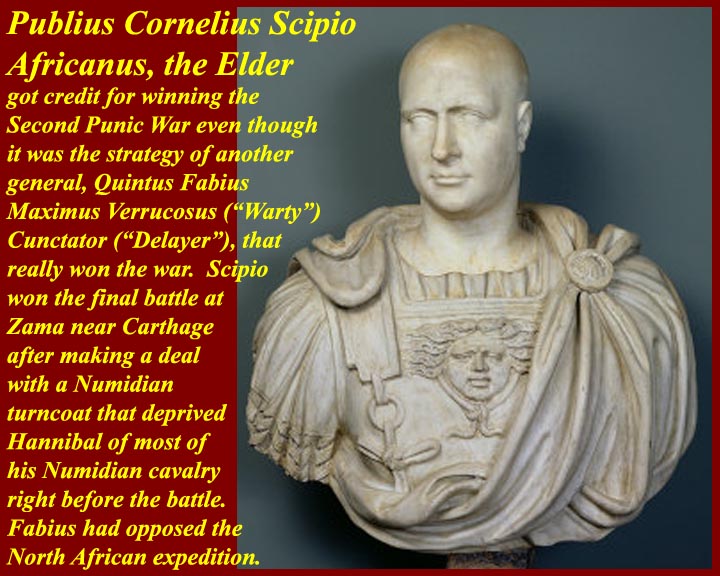
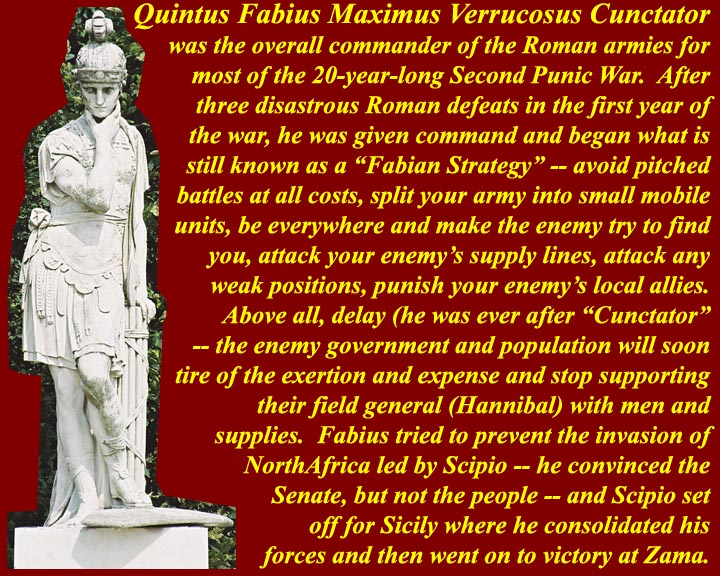
http://www.mmdtkw.org/AU0311aScipioAfricanusMajor.jpg
http://www.mmdtkw.org/AU0311bFabiusCunctator.jpg
http://www.mmdtkw.org/AU0311cElderCato.jpg
The next subject to address is the rise and fall of the Gracchi brothers, and, as background to that, it's necessary to return to the travails of Scipio Africanus the Elder after the Second Punic War. One of the trends prevalent in Rome at that time was Hellenization. Greece had been taken over and Greek customs and values were seeping into Rome. But traditionalists saw only corruption of simple and traditional Roman values. The two competing value systems led to problems. It didn't help that the archetypal representative of Hellenism and traditionalism were Scipio Africanus, who got credit for winning the Second Punic War, and Quintus Fabius Maximus Cunctator, whose "Fabian Strategy" had worn down Hannibal in Italy and, more importantly, who felt he should have been recognized as the real winner of the war. Fabius was also instrumental in the reversal of the reforms of the Gracchus brothers -- see below.
One of the younger officers who had worked for Fabius Maximus was Cato the Elder, who in his youth had already decided that Hellenism was incompatible with Roman simplicity and, more than that, that Hellenism would lead to Rome's downfall. Cato became the "attack dog" of the traditionalists, and his favorite target was Scipio the Elder. We have seen that Scipio retired in disgust to his coastal Campania estate.
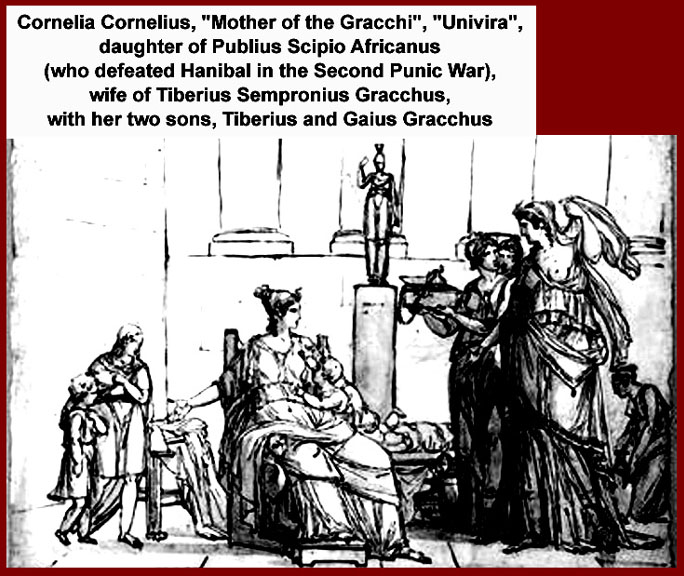
http://www.mmdtkw.org/AU0311daCornelia.jpg
http://www.mmdtkw.org/AU0311dbCornelia.jpg
Scipio had a daughter, Cornelia, who after the death of her father, married Tiberius Sempronius Gracchus an elderly man, and produced twelve children by him, only three of whom survived to adulthood. Her two sons, Tiberius and Gaius, entered the cursus honorum, and her daughter, Sempronia, who was older than her brothers, married Scipio Africanus the Younger. When her husband died, Cornelia refused to remarry, even though, by some accounts, the Ptolemaic Egyptian pharaoh was among her suitors.
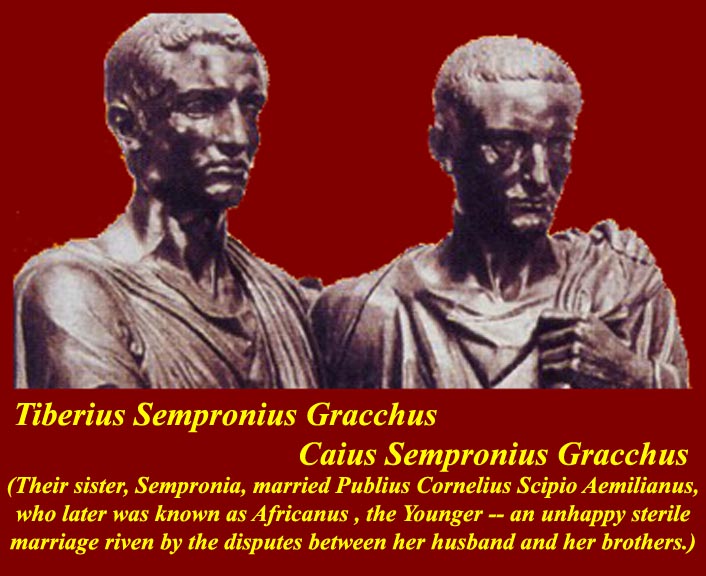
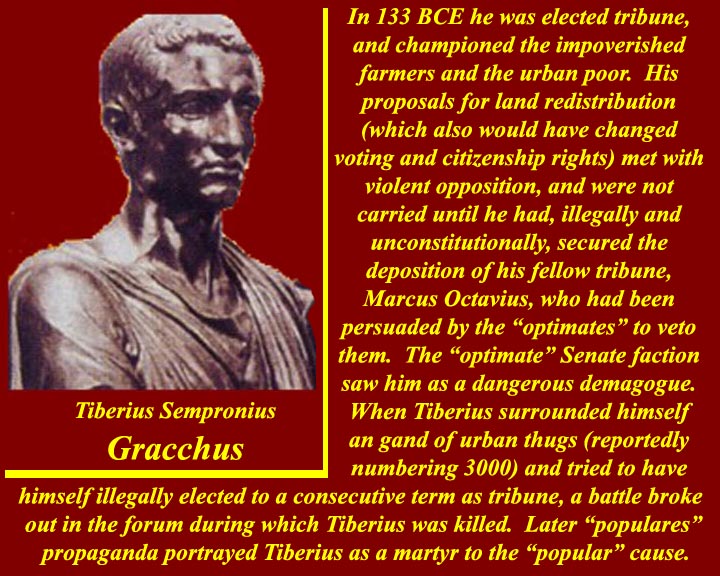
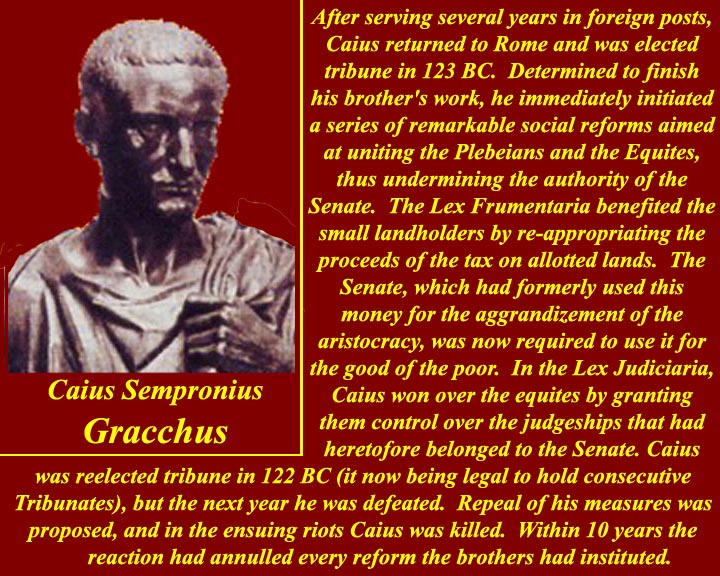
http://www.mmdtkw.org/AU0311eBrothersGracchi.jpg
http://www.mmdtkw.org/AU0311fTiberiusGracchus.jpg
http://www.mmdtkw.org/AU0311gGaiusGracchus.jpg
http://www.mmdtkw.org/AU0311hGracchiPrecedents.jpg
The Gracchus brothers both became populist leaders and Tribunes, taking up the cause of the Plebeians. In 133 BC, Tiberius, the older brother proposed laws that would have redistributed land to the lower classes and deprived the Patrician class, and more specifically the Senate, of some of its power. He also tried to extend his Tribunate (i.e., re-election) for a second year, which was illegal at that time. (He wanted to extend his term in order to preserve the immunity from criminal prosecution that came with being a tribune -- he had illegally, in the course of political disputes, used force to remove another tribune.) All this, of course, made him very unpopular with the Patricians and Senators, who could call on their clients to enforce their will. Tribune Tiberius began to move around the Rome with, according to some accounts, as many as 3,000 members of the Plebeian mob. Neither the Patrician clientelia nor the Plebeian mob were supposed to carry arms in the city (i.e., inside the Pomerium), but inevitably some were armed and some just picked up what was at hand in clashes that developed between what amounted to large street gangs. When it came time for the next election of tribunes, Tiberius surrounded the Curia Hostillia where the Senate was meeting with his supporters and went inside to propose his own reelection. He was armed, but so were the opposition Senators, and almost immediately he was stabbed to death. Inevitably, accounts differed on how it happened. Outside the curia, the mob that had supported Tiberius started to dissolve in confusion, but they did not realize that they, in turn, had been surrounded by an armed group of supporters of the Senators who had killed Tiberius. By most accounts several hundred of the supporters of Tiberius were killed in the Comitium area in front of the Curia. The rest escaped, and it was ten years before the popular faction raised its head again. Laws that Tiberius had pushed through with the support of the urban mob were repealed, and the status quo ante was restored. (For much more detail on Tiberius, see http://en.wikipedia.org/wiki/Tiberius_Gracchus.)
It's easy to think of this as class warfare, and by some oversimplified (mostly Marxist) accounts, that's what it was. It's often said that the Senators simply killed Tiberius, who was trying to institute reform -- and there is some truth to this. But what really had developed were two loosely knit "factions" within the pre-existing power structure, "loosely knit" because alliances shifted quickly as individuals and families sought to retain power or to improve their positions. One faction called itself the "Optimati" or the "Best People" -- a self-styled upper class within the upper class -- for the most part, members of families who had controlled the Senate for generations. The "optimati" derisively called the other faction "populares", which we can translate, anachronistically, as "populists". It's important to remember that the leaders of the "populares" crafted their "platform" to appear to be supporting the aspirations of "the people", but that those leaders were, themselves, also members of the same social class that produced the Optimati. Populares leaders like the Gracchi hoped to oust the Optimati and replace them in the leadership of the Senate and hoped to take over the higher magistracies of the cursus honorum. To do this, they mobilized Rome's urban mob. But the clientelia of the optimati were just as much an urban mob, drawn from the same classes as the mob that supported the populares; the desperate classes of Rome were available for hire.
In 123 BC, ten years after the death of Tiberius Gracchus, Gaius, the younger brother was elected to the tribunate and events repeated themselves. But Gaius added a new twist. He realized that the power base that Tiberius had forged was too narrow, so this time around Gaius also proposed laws that appealed to the aspirations of the merchant equites class. His program included not only agrarian laws, that stated that lands illegally acquired by the rich should be redistributed to the poor, but also laws that regulated the price of grain. He also tried to limit the number of years and campaigns a man was obliged to serve in the army. Other measures included the reformation of the extortion court, which prosecuted illegal appropriations of money by members of the Senate and a law concerned with the constitution of juries, which were previously composed only of Senators, subject to bribery, who would judge their peers. His law changed the jury-draft pool to include equites. He also proposed the extension of Roman citizenship to several Italian allied nations. All of these displeased the more conservative optimati Senators. Using the force of his supporters, Gauis got himself illegally reelected in 122 BC and continued his reforms. But the next year his ticket lost the election, and the two Optimati consuls, Quintus Fabius Maximus and Lucius Opimius started to repeal the reforms that Gaius had pushed through. Gaius tried to use armed force to prevent the repeal, but the senate declare him and his followers enemies of the state. Gaius's men lost the in the clashes that followed and eventually Gaius fled with one of his servants. The story here gets murky. Plutarch says that Gaius ordered his servant to kill him and that the servant then killed himself. Other accounts say that the servant was in the pay of the Optimati. Then, according to legend, an enemy of Gaius took his head to a client of Opimius, who, it was said, cracked the skull open and filled it with molten lead. The head, now weighing 17 pounds, was then taken to Opimius, who paid this weight in gold, as he had promised.
(For more information on Gaius, see http://en.wikipedia.org/wiki/Gaius_Gracchus.)
The Gracchi reforms and the Populares' attempt to gain power failed this time, but they would be back. The renewed struggle will be the subject of Unit 5 of this course.

